Pygmy Hippo 2017: in search of a podgy unicorn
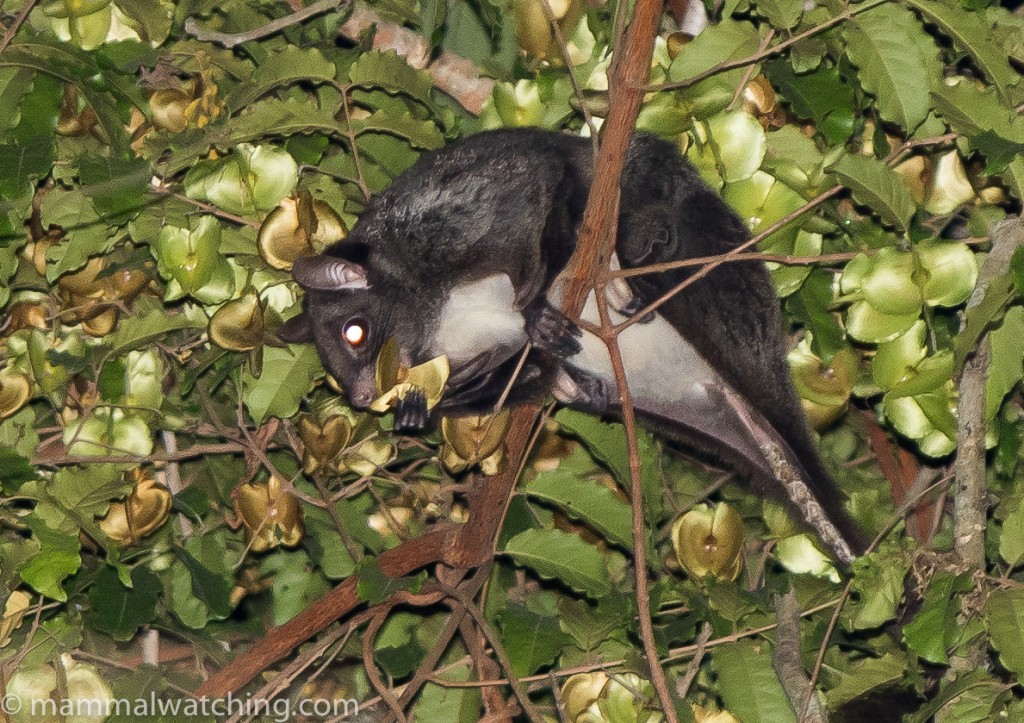
Lord Derby’s Anomalure, Anomalurus derbianus, Tiwai Island
Perhaps it is because of their rarity, or how secretive they are, or maybe, like me, you had a formative encounter with one at the zoo when you were seven, but Pygmy Hippos are a mammal watcher’s mammal. They had been on my bucket list since forever.
I had not, however, been able to track down any information about somewhere that offered a decent prospect of seeing one. My one and only lead was learning that a birding tour had (probably) heard one on Tiwai Island, Sierra Leone. So when Tobi Lundqvist and Ben Schwienhart visited Sierra Leone in quick succession at the end of 2016 I was fascinated. Tobi didn’t look for the hippos but saw some other nice mammals while Ben came very close to seeing a hippo and found a lot of great species in the process.
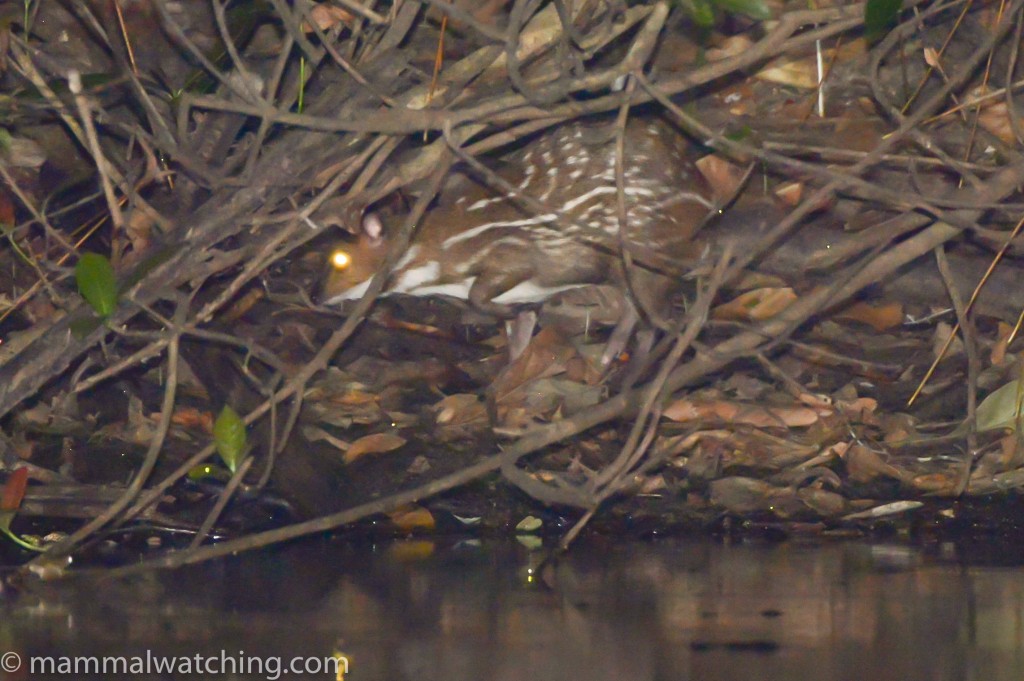
Water Chevrotain, Hyemoschus aquaticus. Gola Rainforest National Park. Photo by Phil Telfer.
How could I resist? A few weeks later Phil and Ashley Telfer, Charles Foley and I were flying into Freetown for a 10 day trip, armed with a thermal imaging scope and unbridled optimism.
Practical Advice
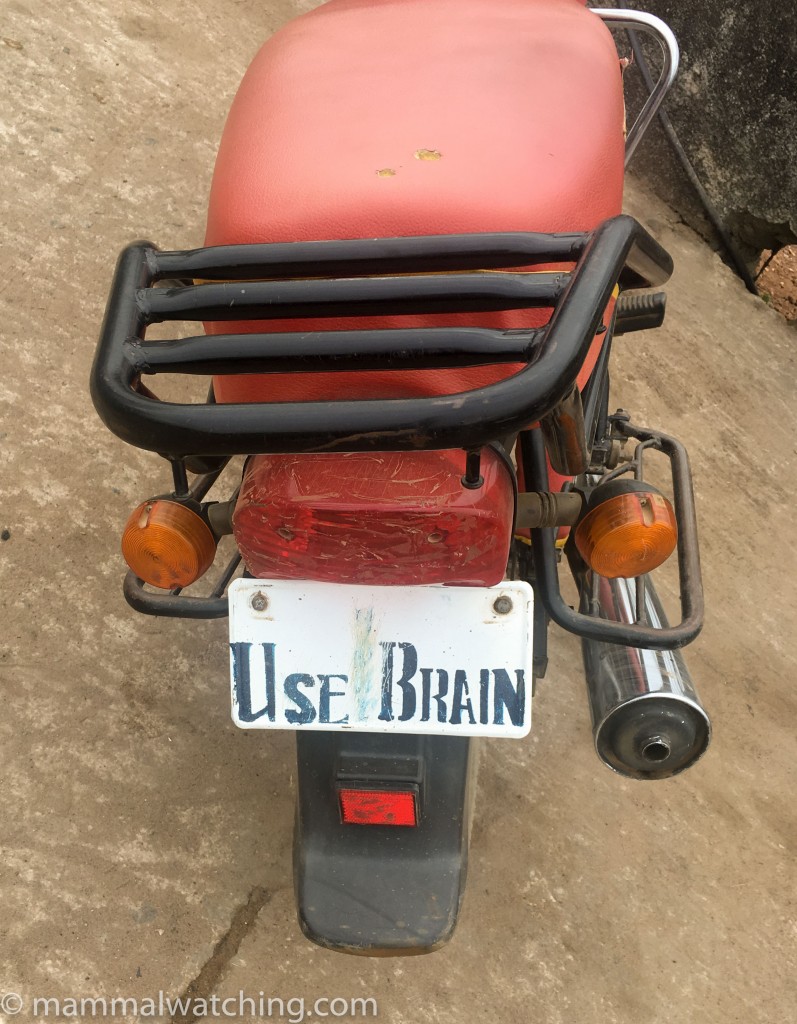
I knew nothing about Sierra Leone before I got there other than it had been home to blood diamonds, child soldiers and, particularly, Ebola. It is hard not to think about Ebola when you are there, especially when you see posters warning you of the dangers of washing dead bodies. But that occasional shiver was the only concern I had during my stay. The Sierra Leoneans are exceptionally friendly people; I honestly don’t think I have been anywhere where people are so ready to smile, wave or laugh. Even the few police roadblocks we encountered were friendly.
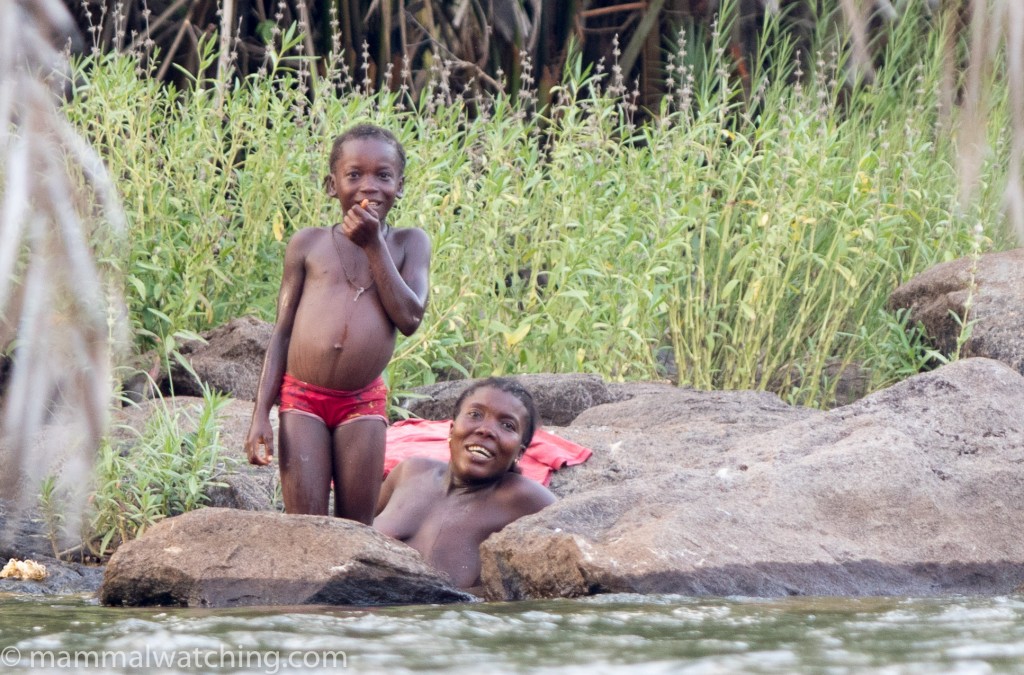
Moa River, Tiwai Island
The country has had far more than its fair share of tragedy from the brutal civil war in the 1990s to the 2014-16 Ebola outbreak. It is one of the world’s least developed nations (only 20 countries are lower on the Human Development Index and only in Swaziland do people live shorter lives). And yet, despite all this, some wildlife has clung on.
I can think of few places where mammal watching can make such a positive contribution to conservation. So few tourists visit, and the communities are so poor, that every single visitor makes a difference to the viability of the Gola and Tiwai forests and to the protection of many endangered species.
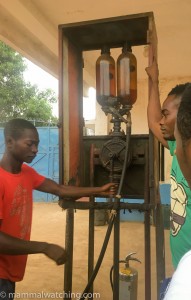
Hand pumped petrol
The country is desperately poor but we felt completely safe the whole time we were there, except for the time our dozy driver hit a speed bump at 70 kmh. Despite the difficulties of getting things done in a place like this, our trip was impeccably organised and all the guides we worked with were hard working and reliable.
Phil took the lead in organising the trip and worked through the guys from the RSPB at Gola Rainforest National Park. RSPB, a British bird conservation charity, started managing the Gola Community Forest, and the Liberian chunk of contiguous forest on the other side of the border, many years ago because of the area’s importance to White-footed Picarthartes (a bird!). The forest is now a national park and RSPB are promoting ecotourism to the area to help protect and sustain it. Benjamin and Pietro at RSPB organised the Gola leg of our trip flawlessly. They also set up our visit to Tiwai with the community there: this too went without a hitch.
When To Go
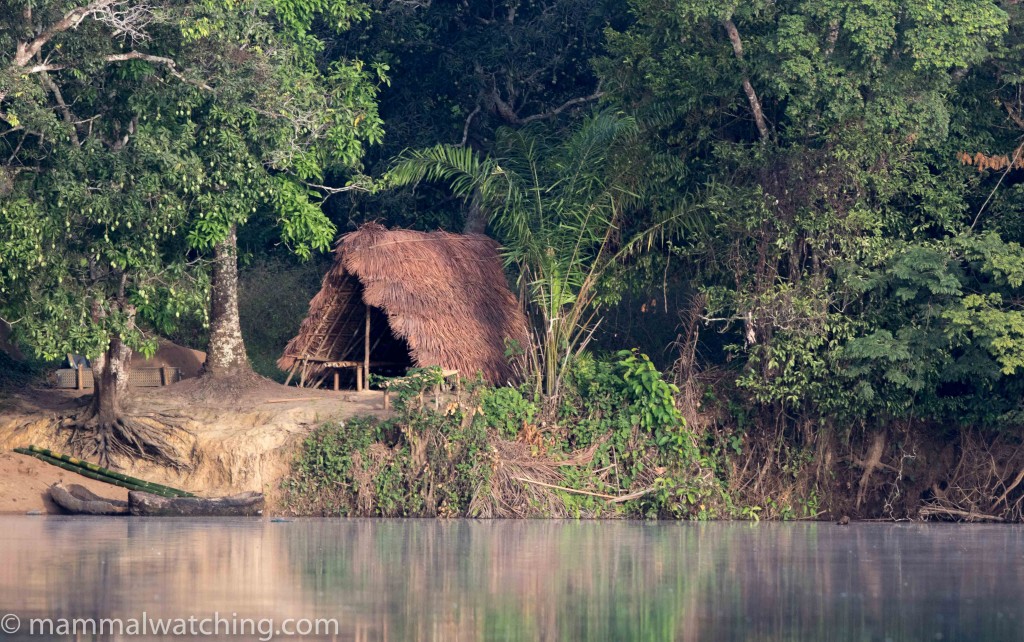
Across the river from Tiwai Island
March and April, at the end of the dry season, are reputed to be the best times to look for Pygmy Hippos on Tiwai Island at least. This is largely, I think, because the low river is easier to navigate by canoe. I am not sure hippos are any harder to see in the rainy season at Gola (there was no option to use boats there), though the I suspect it is easier to look for their tracks on the bank when the river is low. The climate would be a lot more pleasant at other times of the year, unless you like hot and grotesquely humid: any activity in the forest during our visit rapidly turned into a sauna.
It rained every second or third night when we were there: each time it lasted an hour or two and was torrential. This was unusual and we were told the rainy season had started a month early.
Where To Go
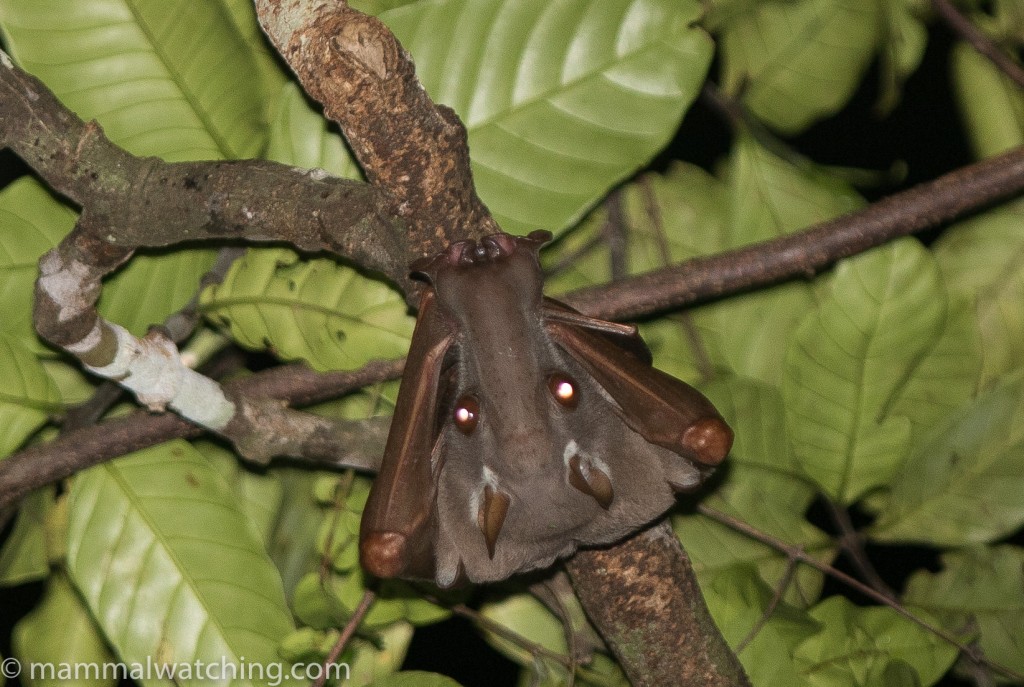
Hammer-headed Bat, Hypsignathus monstrosus, Gola Rainforest.
We followed Ben Schwienhart’s advice and divided our time between Tiwai Island and Gola Rainforest National Park, as these places seem to afford Sierra Leone’s best chance to see a Pygmy Hippo.
In Tiwai we stayed in the research station, and slept in bare rooms in a small dormitory. We spent time each day on the river and also walked – generally unsuccessfully – the network of trails around the island.
In Gola we spent two nights at the Sileti Sub Station (sleeping in a house) and four nights camping at two locations.
I suggest visiting both locations, spending a minimum of three nights in Tiwai and four in Gola. It takes time to see animals here and we were still seeing new species each day after 10 days.
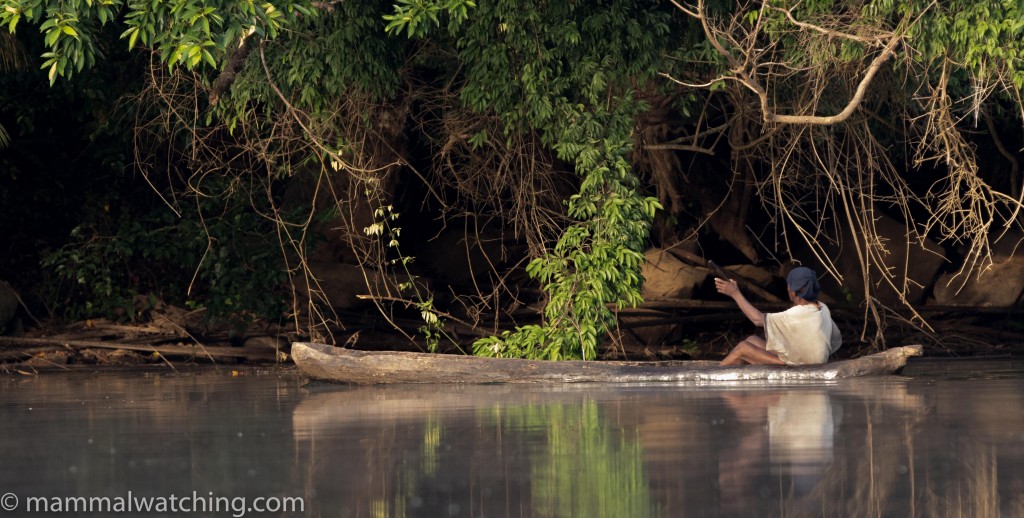
Moa River Dugout
It was too hot and humid to sleep well. There was no hot water, no wifi and no phone coverage anywhere. We had power in Tiwai, and for a couple of hours each night at Sileti.
The Food
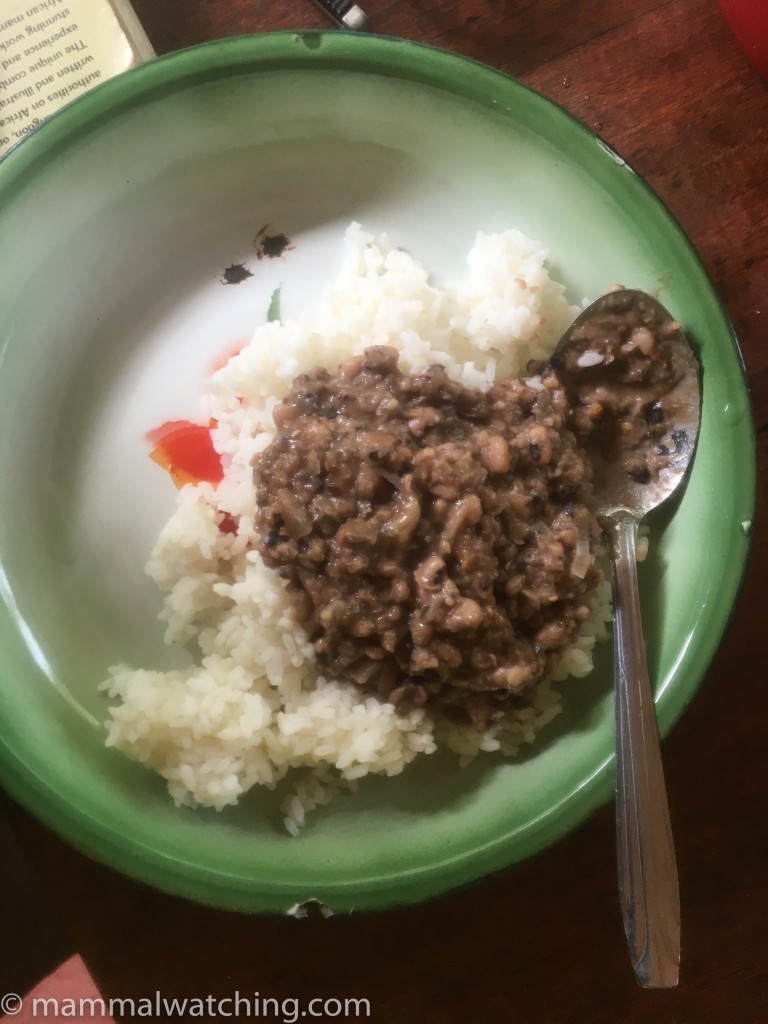
Staple diet
It would be difficult to market Sierra Leone as a destination for foodies. Meals were largely identical be they breakfast, lunch or dinner: rice with a spicy sauce featuring peanuts (for me and Charles) or fish (for Phil and Ash) topped with industrial quantities of palm oil. It was actually very tasty but I am not in a hurry to order it again.
Breakfast at Tiwai was a departure, and featured pancakes, sometimes with egg, and once with something pink that may have been Spam in a previous life.

Breakfast of champions (and the desperate)
Ash was the only one brave enough to try this. So far as I know he is still alive even if he must have sold his taste buds to the devil.
The Mammal Watching
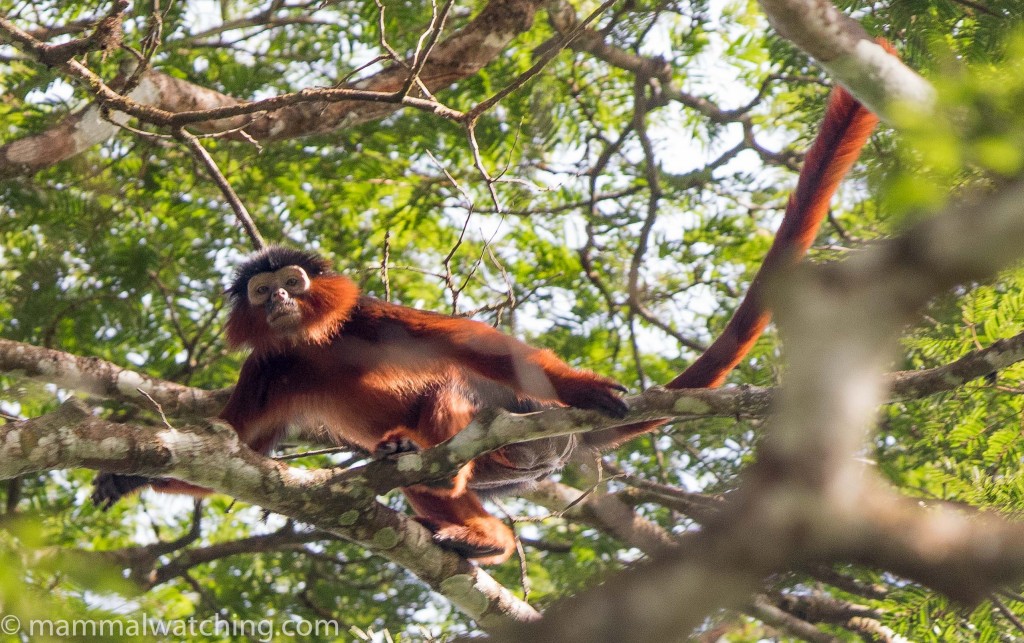
Western Red Colobus, Procolobus badius
The mammal watching was tough going. The humidity was exhausting. And, though well maintained, most of the trails are narrow tracks through dense forest which limited opportunities to see things (the exception was the “Mahoi Road” in Gola, a disused road running through the rain forest that offered a bigger field of view in all directions). Though our local guides were fine people, it was pretty obvious they did not have much experience in looking for animals nor any plan on how best to do it. More of this later.
Photography, always a challenge in the rainforest, was even harder than usual here. So much so that towards the end of my trip I stopped carrying my (very heavy) camera if I was walking more than a kilometre: the trade-off between effort and sweat versus photographic possibilities wasn’t making the cut.
I don’t know how many animals are left in the forests we visited and how close their numbers are to levels of natural abundance. Both areas seem quite well protected but they must have been hammered in the civil war during the late 1990s and in many ways it is impressive that anything survived. Our impression though was that the forest was still recovering, with ungulates in particular (judging by the absence of dung) much sparser than you might expect. The animals we encountered were skittish and we saw less than we heard.
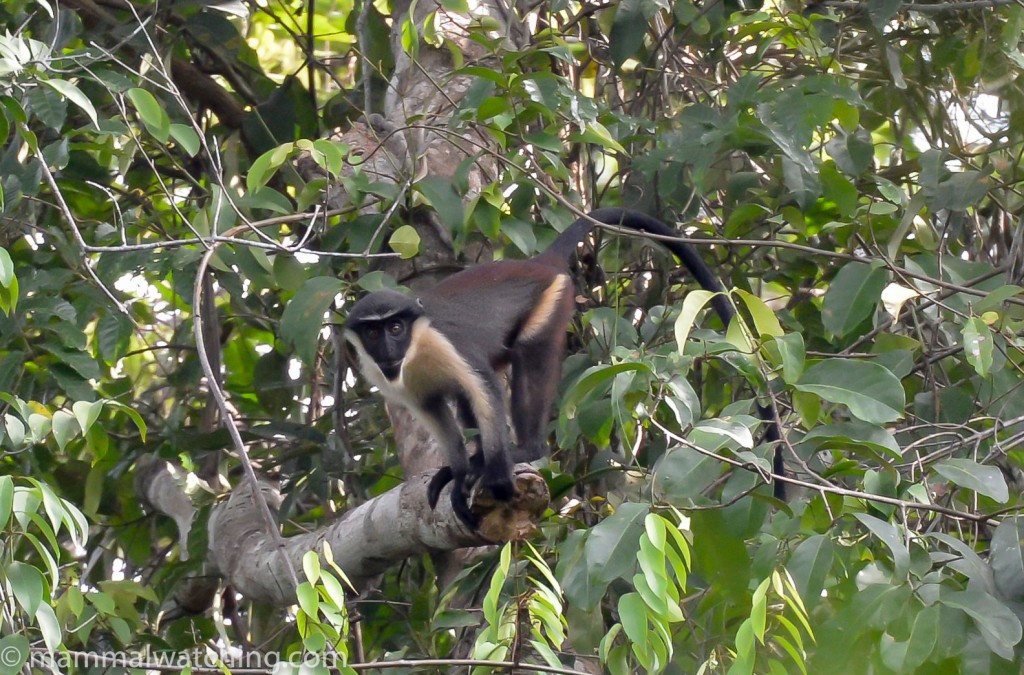
Diana Monkey, Cercopithecus diana, Tiwai Island. Photo by Phil Telfer.
The story is different though for primates. Tiwai Island has a remarkable abundance and diversity of primates, perhaps the highest in the world on both counts? We heard monkeys every 10 minutes or so while walking in Tiwai’s forest, and in one 24 hour period we saw 11 species of primates (only missing Chimpanzees which are occasionally encountered).
We found the river trips were the best way to observe monkeys and, though far from habituated, they were considerably less nervous on Tiwai than in Gola Rainforest. In fact although we heard three species in Gola reasonably often, I didn’t get a good look at any of them. The best you could hope for there was the occasional glimpse of an animal crashing away from you through the canopy like a bat out of hell.
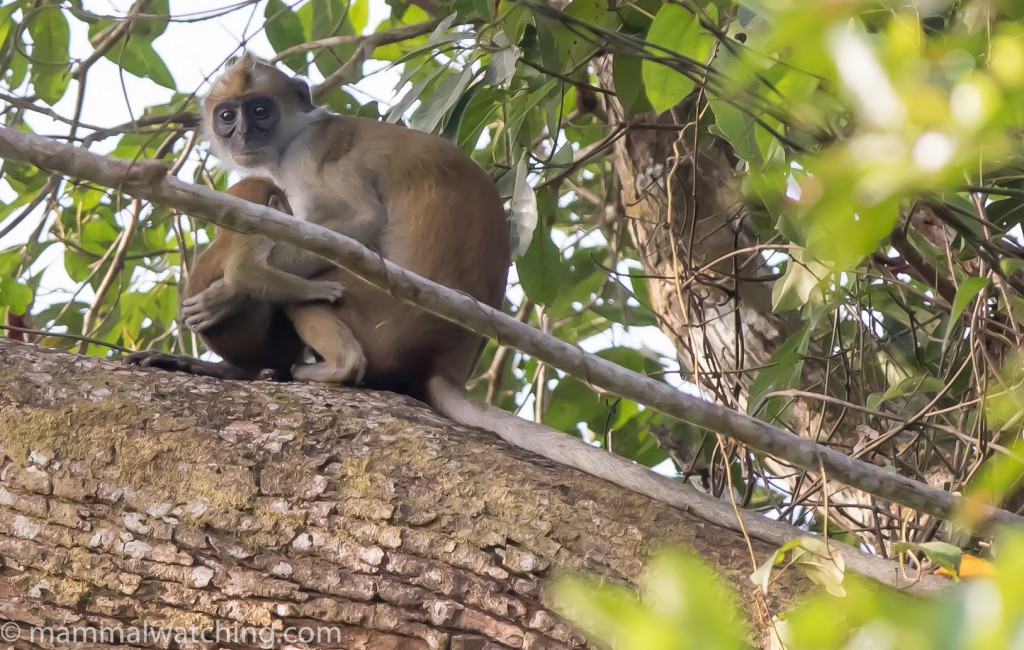
Olive Colobus, Procolobus verus, Tiwai Island.
We eventually all got our fair share of bug bites (mainly from tiny black flies that hung out at the river during the day), but most areas seemed devoid of biting insects and I didn’t see a single mosquito. None of us found ticks and I learned – from Charles – that Africa is leech-free. I’m not sure I could have coped with the humidity had I had to wear more clothes to cover my skin.
The only encounters of note were Charles’s run in with a woolly caterpillar and Alusine, our guide on Tiwai, almost treading on a Gaboon Viper.
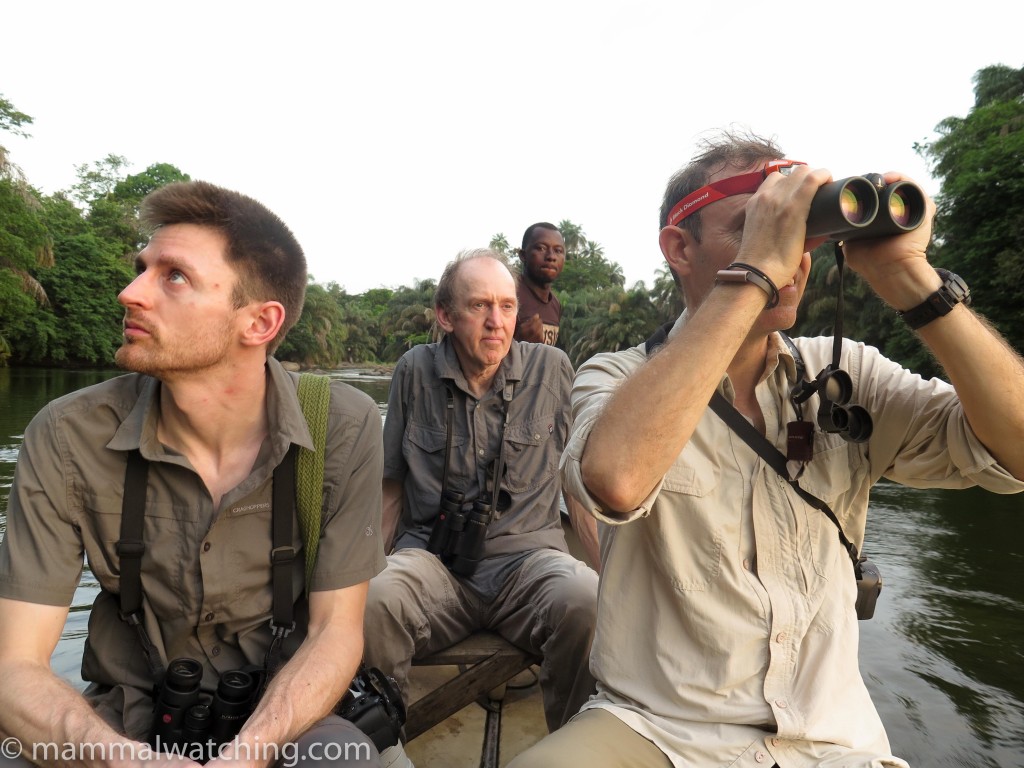
Mammal watchers
We travelled as a group of four and often walked the trails together with a guide. When looking for mammals there is a trade-off between what extra pairs of eyes can spot and the noise that extra pairs of feet generate. I think walking the trails here would be much better done alone (though pack a GPS): the path is narrow and the best chance of spotting terrestrial stuff is to hope it shoots across the track in front of you. Those at the back have precious little hope of seeing much and, indeed, on our first morning, the back half of our group missed Red River Hogs (much to my dismay because I was in the back). All the ungulates I saw were while I was walking alone or with Charles.
Lungi Airport
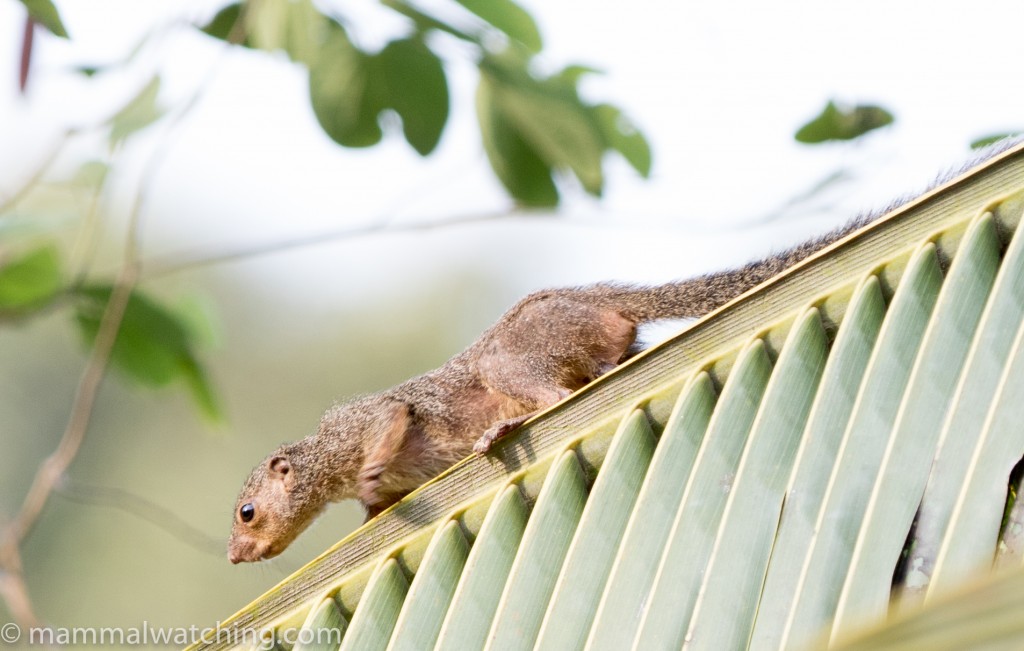
Green Bush Squirrel, Paraxerus poensis
Getting to Freetown, the capital, from the airport requires a boat trip, so it makes sense to stay near the airport. It did not however make much sense to stay at the Lungi Hotel where we were. It is expensive – ridiculously so – by Sierra Leonean standards, so I was expecting a palace, rather than the shabby hotel, with intermittent power and wifi, that we checked into. Worse, we used Booking.com only to discover on checkout that the hotel didn’t take credit cards, which meant a last minute trip to the ATM to withdraw multiple batches of cash.
We returned to the same hotel for the afternoon before our flight home. The manager on duty was a piece of work who insisted, after we finished lunch, that we had to pay to use the pool, had to pay $50 to rent a room for an hour if we wanted to shower, and then – to cap it all – had to pay $5 each to use the hotel shuttle bus to travel the 250 metres to the airport! A very different way of doing things when compared to the scrupulous honesty we had encountered elsewhere.
We did however get our first good look at a Green Squirrel by the hotel pool.
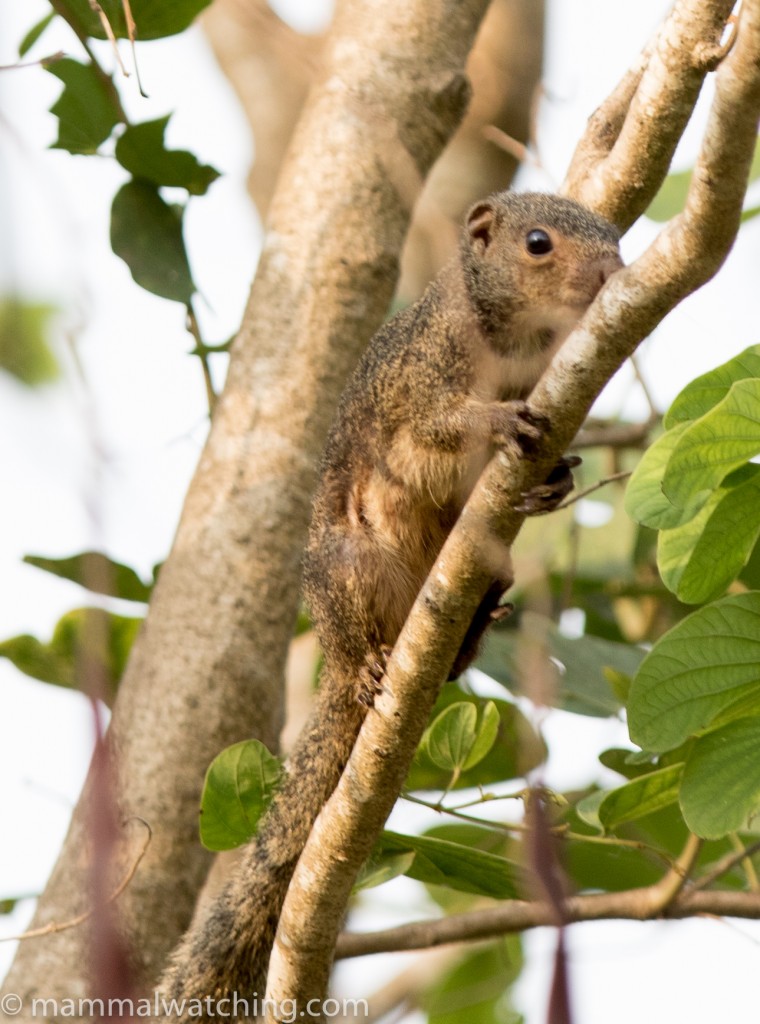
Green Bush Squirrel, Paraxerus poensis
If I was going back I would stay at the Lungi Airport Lodge for a fifth of the price and – I am sure – five times the friendliness.
Tiwai Island
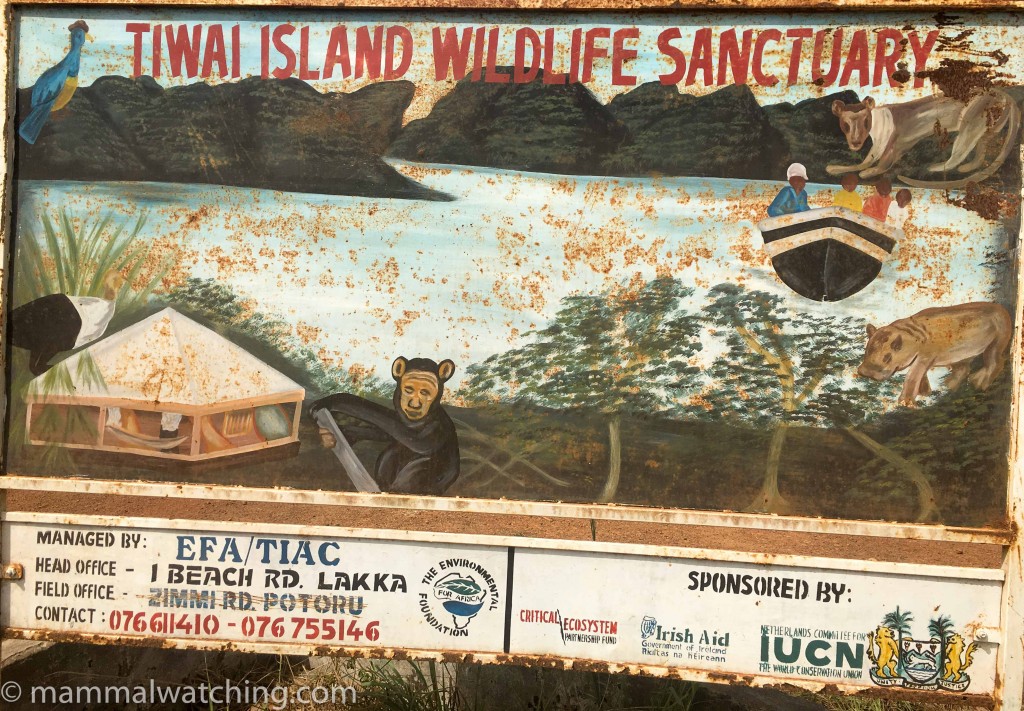
Welcome to Tiwai Island
It takes the best part of the day to drive from Lungi to Tiwai Island, particularly when your driver doesn’t know the way. Our driver didn’t. He eventually hired a motorcyclist to navigate the last leg of the trip but soon discovered that his new recruit didn’t know the way either. Somehow we found it.
Tiwai Island is a 12 square kilometre slab of rainforest in the middle of the Moa River in south east Sierra Leone, very close to the Liberian border.
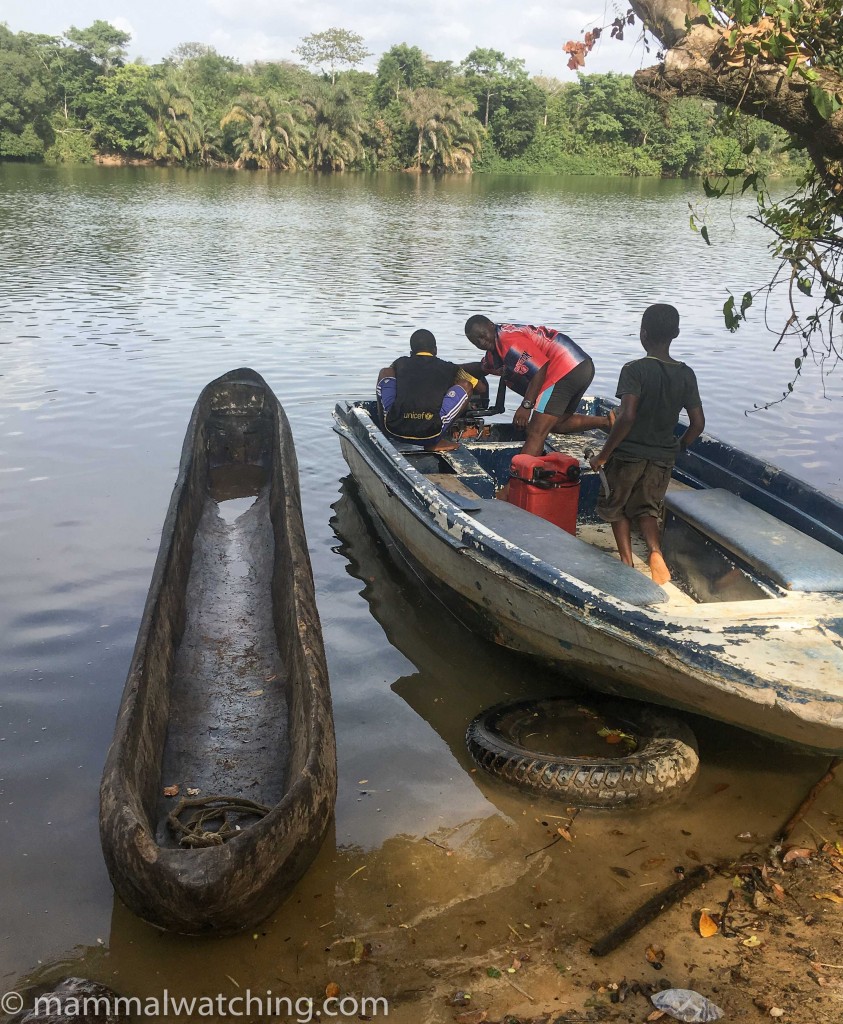
Travelling to Tiwai Island
We arrived in the late afternoon and met our fabulous guide Alusine. I don’t have enough good things to say about Alusine. He speaks excellent English, was totally reliable, willing to work all hours, and I would happily have paid him five times what he nervously asked for as a guiding fee. He doesn’t have a smart phone (they don’t seem to work on Tiwai) so the best way to get in touch would be through the people at Gola Rainforest if you are organizing a trip to both areas, or through one of the local travel agents. I can give you his phone number if you want it.
Tiwai is run by the community who share the proceeds from stays like ours. We were presented with a very reasonable price list for different activities including day and night walks, canoe trips and motorboat trips. Nothing is expensive.
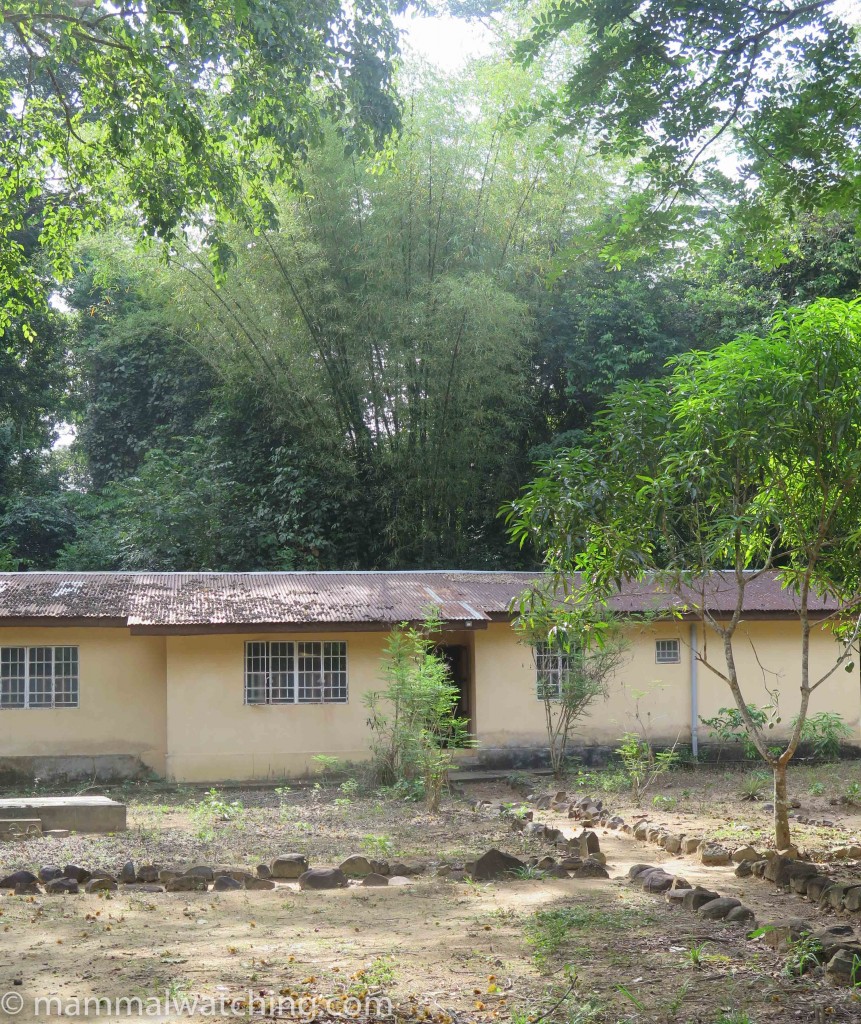
Research Station accomodation
We stayed in the research station, a half a mile from the campsite. Food would appear at random times but we were never hungry. It was, however, sometimes a struggle to get coffee and tea: when we ran out of coffee and asked for more we might be lucky to get two single cup sachets of Nescafe. We were able to order warm beer, which was brought from the nearest town for a small fee.
Though Alusine had helped researcher April Conway with her hippo study on the island it was soon apparent that he didn’t have much of an idea on how we might find one. He suggested walking the trails early in the morning in case we flushed one and, indeed, he and I got close on our last morning, finding fresh dung and sign that might only have been an hour old. However, I suspect there is very little chance of a group of five of us bumping into a hippo like this, and no chance whatsoever of everyone getting a view.
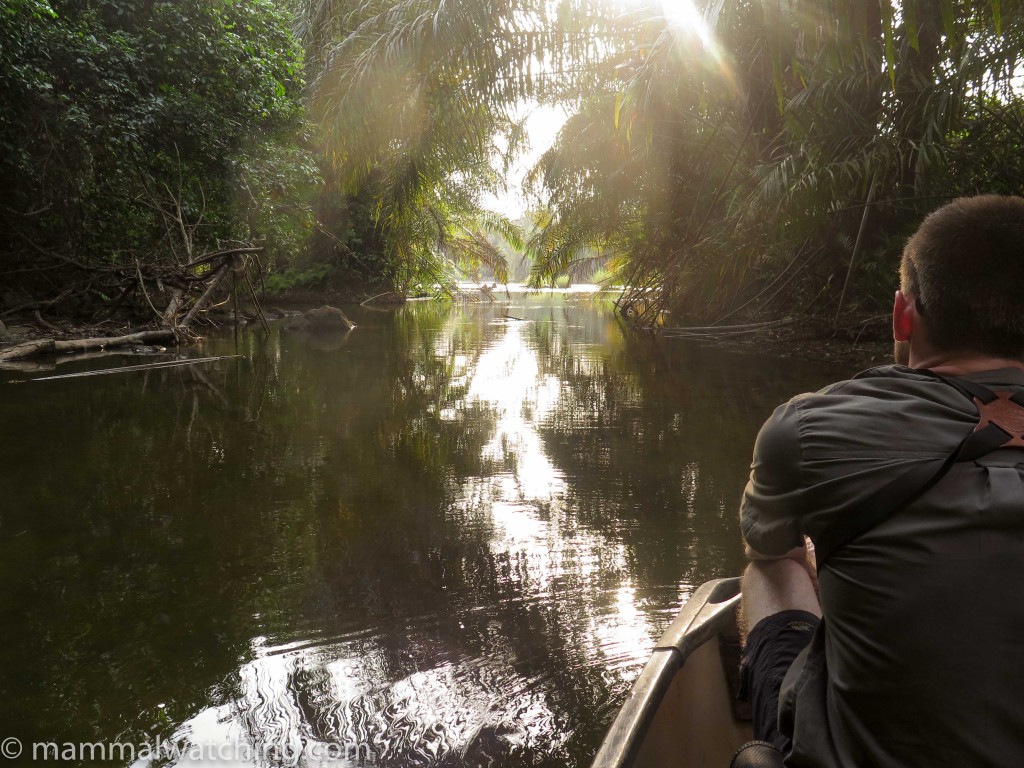
Hippo patrol on the Moa River
We tried canoeing the Moa River in the early morning and late afternoon. This seemed like a better plan, particularly when Alusine took us up some quiet oxbow lakes which seemed perfect spots for a hippo to rest during the day, but we didn’t score. It is lovely out on the river, though pack a cushion if you value your buttocks.
What felt like the most promising approach, which we tried only on our last night, was to take the motorboat up river at dusk and then drift back in the dark using flashlights and my new thermal scope to look for hippos. Again we didn’t get lucky but if I was to return to Tiwai I would try this a few times as it felt like a better way to go.
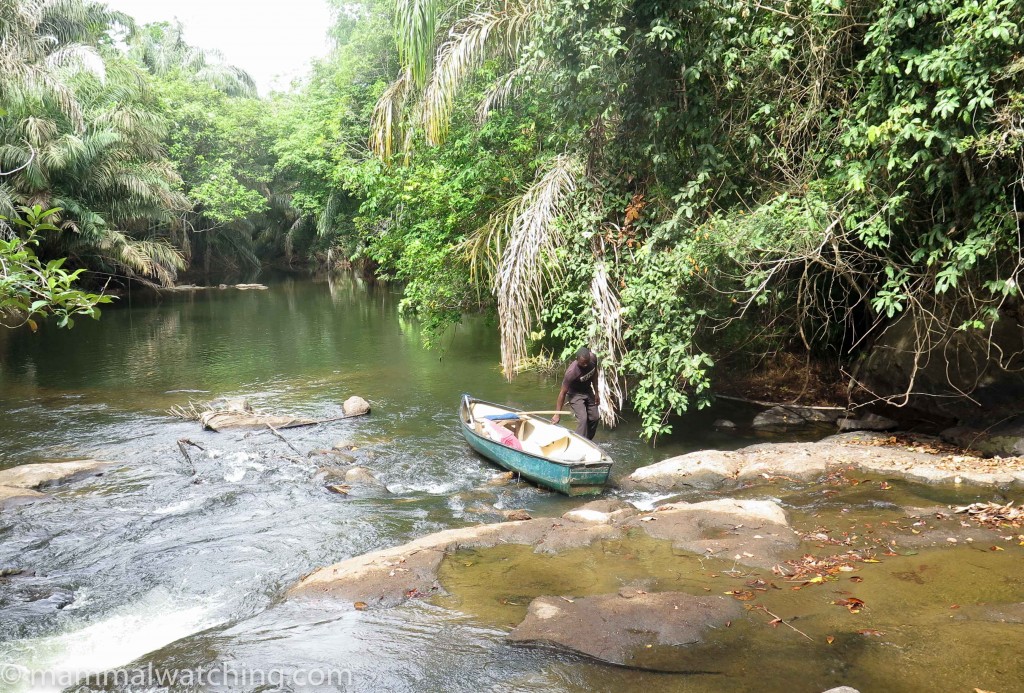 Portage on the Moa River
Portage on the Moa River
What was missing at Tiwai was a focus for our hippo searching. We suggested to Alusine that it could be effective to start a salt lick in the forest a week or so before a group arrives. He thought that would be a good idea, and seemed ready to purchase salt in advance though you would probably need to send him some money.
Alusine said duikers, especially Maxwell’s Duiker, were common on the island but we didn’t see or hear any. We did, however, have several encounters with Red River Hogs which seem quite common. During our first morning’s walk we heard one animal and then came across a group of four or more adults and young. Alusine, Phil and Ash saw them, Charles and I, at the back of the line didn’t. This was painful as Red River Hogs are one of my 21 most wanted species. I figured we would bump into more during our stay but we didn’t, probably because we focused on river travel for the rest of the trip, rather than walking the trails through the swampier bits of forest where the pigs hang out (during a short walk through the swampy area on my last morning I heard another pig).
Primates
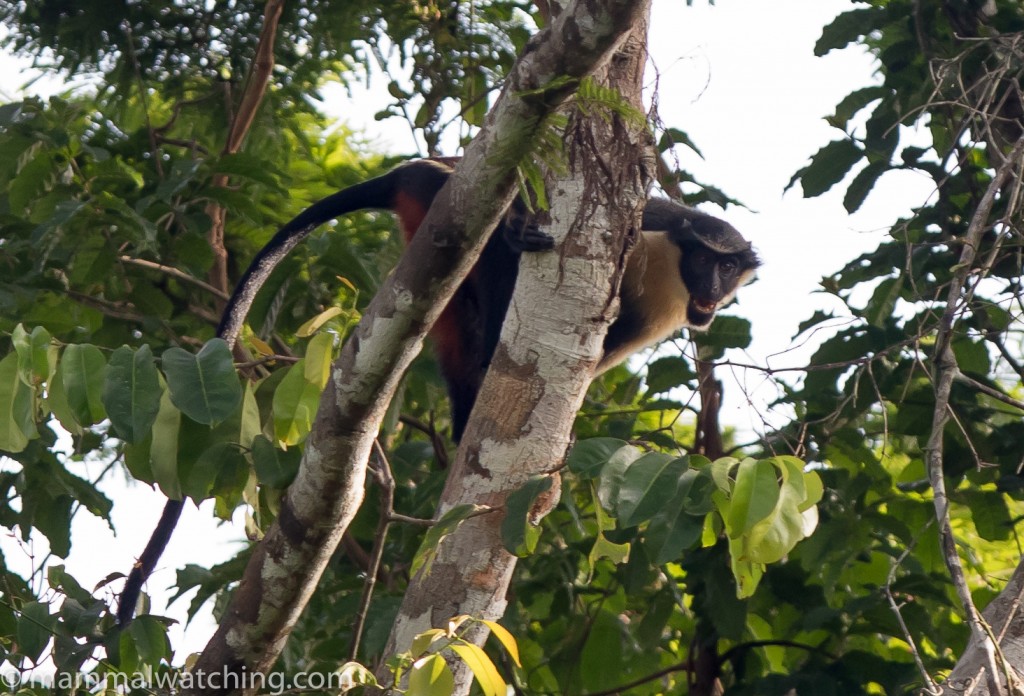
Diana Monkey, Cercopithecus diana
Though just about everything we did on the island was geared around seeing a hippo there is a good deal else to search for there, not least the 12 species of primates that have been recorded in the forest.
It was impossible not to see or hear monkeys and, though photography was often a challenge, we had great views of most species during our four nights on the island. Western Red Colobus, Western Pied (King) Colobus, Diana Monkeys, Sooty Mangabeys and Campbell’s Monkeys were all abundant.
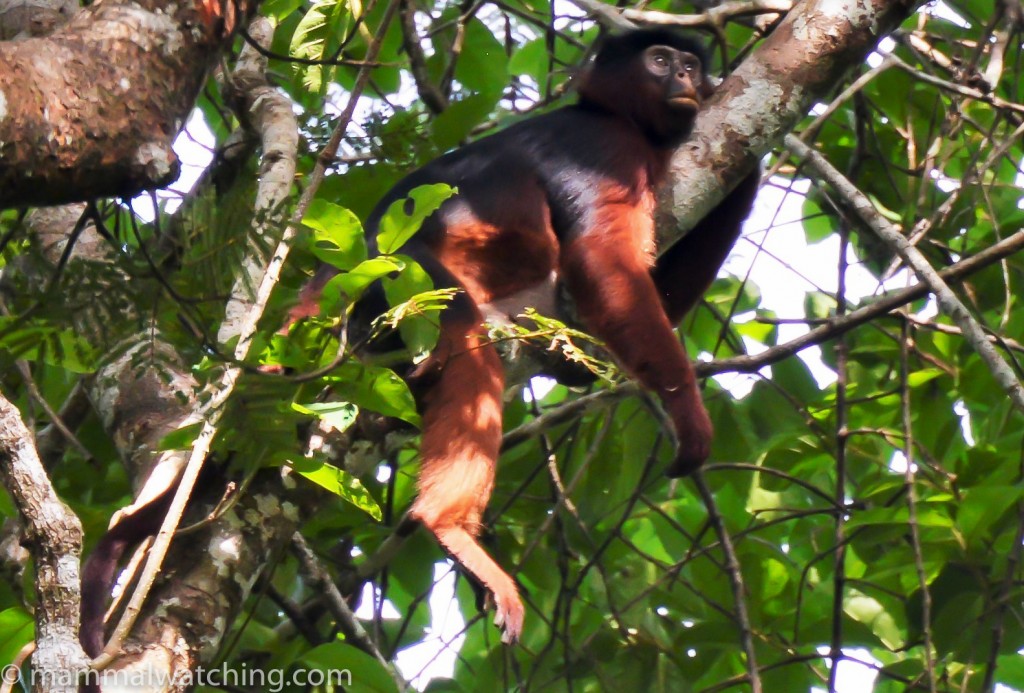
Western Red Colobus, Piliocolobus badius. Photo by Phil Telfer.
The Red Colobus and the Diana Monkeys in particular were gorgeous. The Red Colobus have a very rich red in their coats, contrasting with their black backs, while the Diana Monkeys are spectacularly marked with black, white and red. None of my photos do them justice.
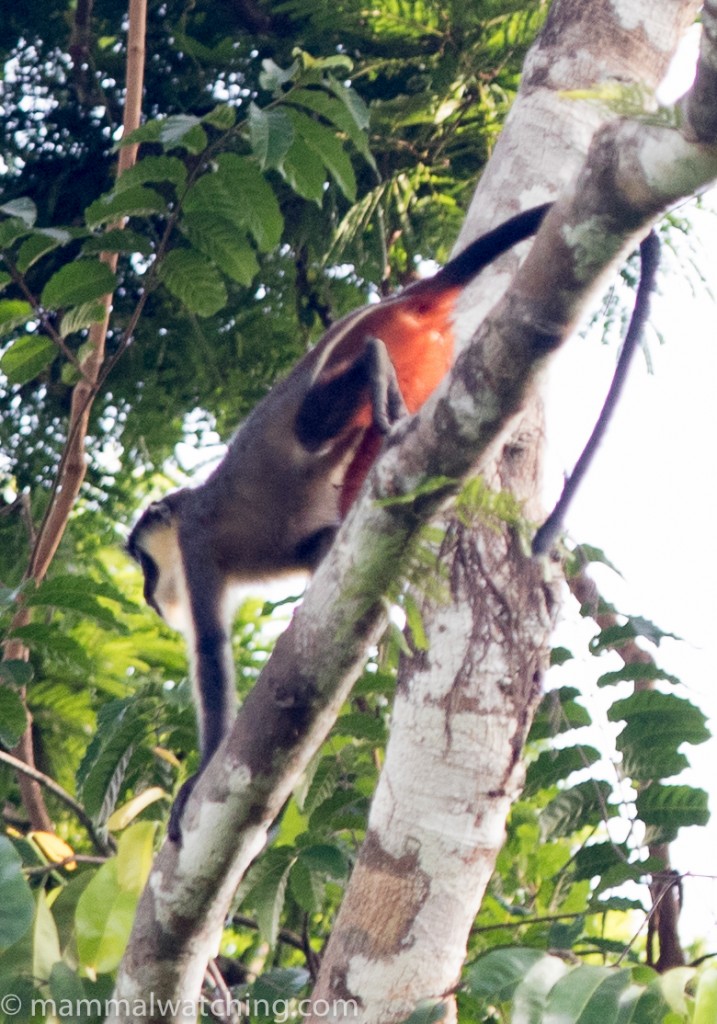
Diana Monkey, Cercopithecus diana
Lesser Spot-nosed Monkeys, were supposedly common, but harder to see during our stay: we only saw a distant animal along the river one morning.
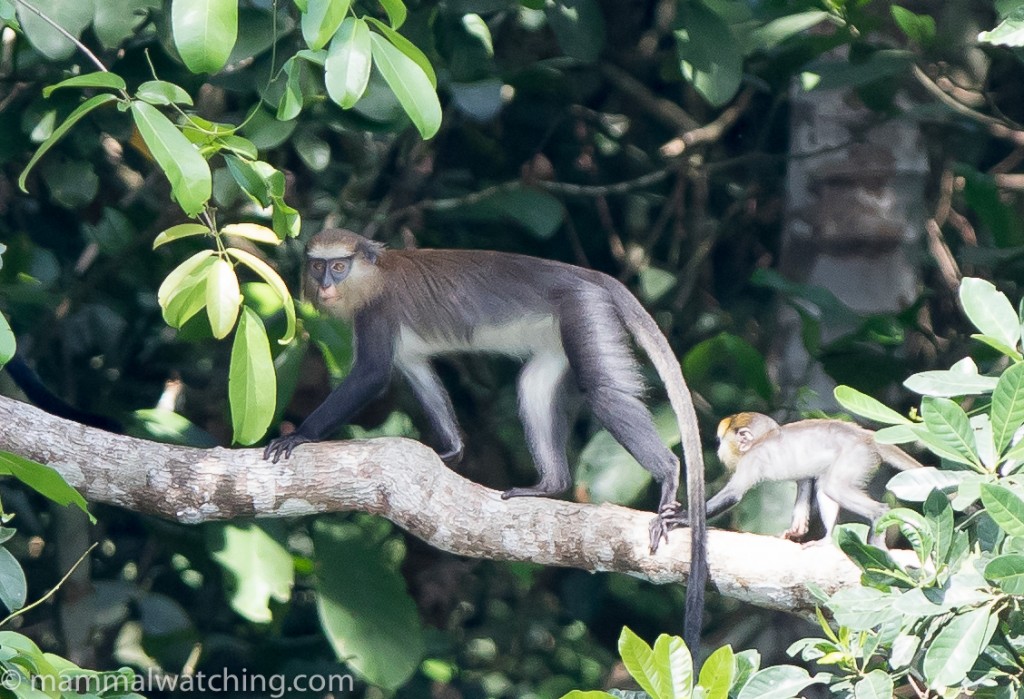
Campbell’s Monkey, Cercopithecus campbelli
Alusine said that Green Monkeys, while quite common along the river, were hard to see in the forest. We found a small group along the river bank.
Olive Colobus are a notoriously inconspicuous species, but Charles spotted a mother and infant in a tree at the river’s edge. She obligingly froze for photos.
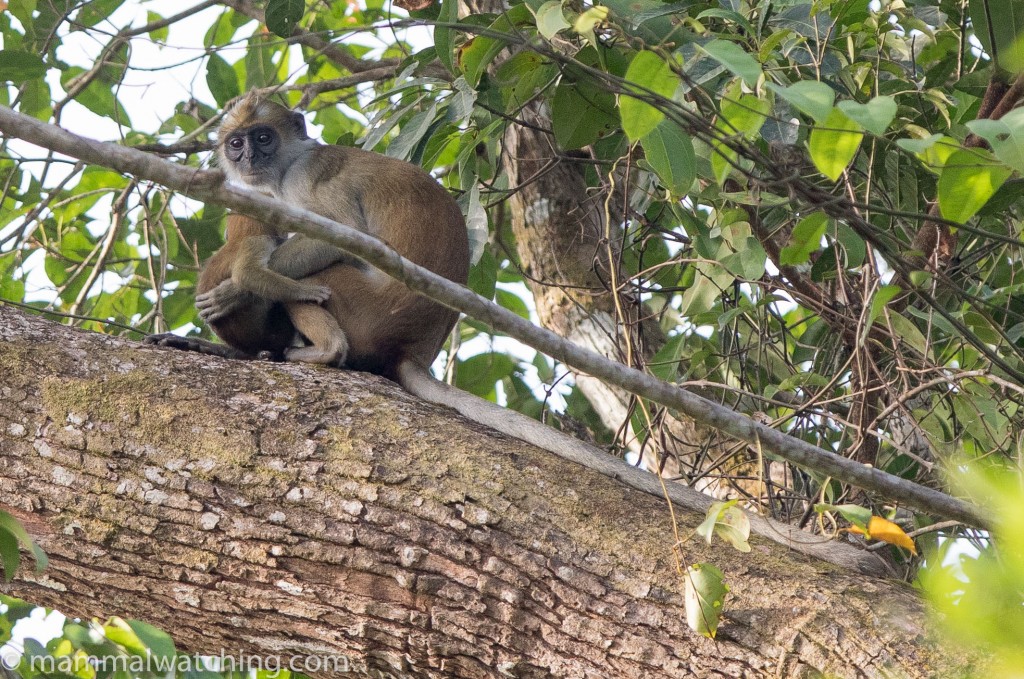
Olive Colobus and infant, Procolobus verus, Tiwai Island
Mornings were the best time to look for primates and though we saw three or four species during a morning walk, we spotted all eight diurnal monkeys during a similar period on the river one morning from the motorboat.
Spotlighting
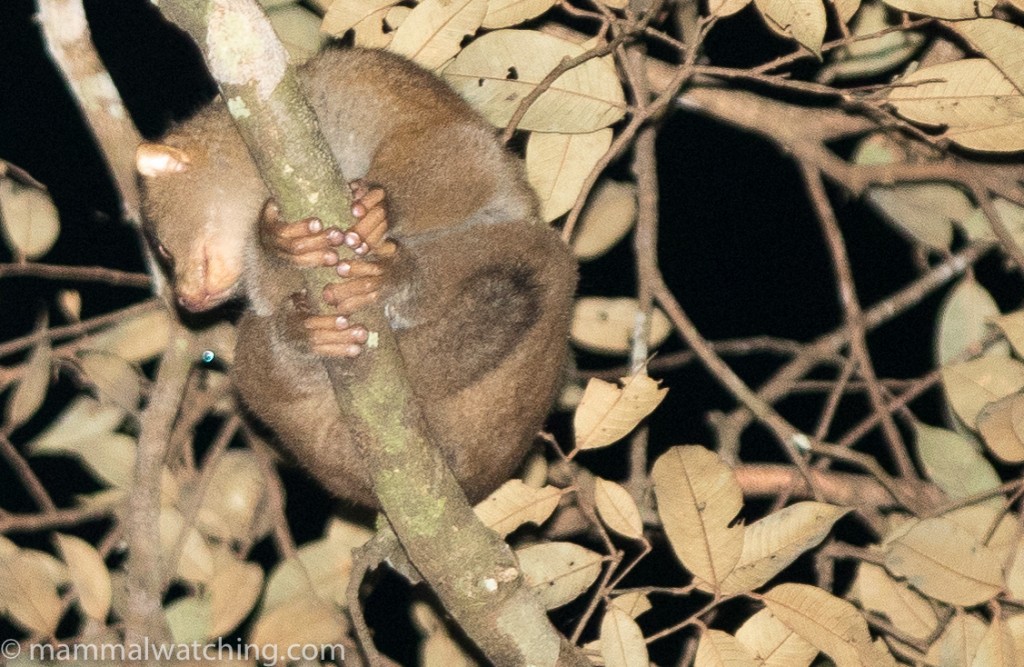
West African Potto, Perodicticus potto
Night walks on Tiwai were unproductive, though it was almost impossible to hear anything with five of us trampling through the bush. I joined a walk for two of our four nights there and was rewarded both times with just a West African Potto and a Demidoff’s Galago, though we heard Thomas’s Galago too (the calls of Demidoff’s and Thomas’s Galagos are – along with habitat preference – the best way to distinguish these species and a very useful call library is here).
For our third night Charles and I decided to stay in camp and catch bats. Phil and Ash took a walk with Alusine who nearly stepped on a Gaboon Viper! This is a snake I would dearly love to see but the animal slithered off the trail and though the Telfers got a great view they weren’t carrying cameras.
Back at the research station I shone my headtorch into a tree in the middle of camp and was astonished to see an anomalure looking back at me. But not the Lord Derby’s or Beecroft’s Anomalure we had been expecting. This animal was white and almost black , and looked to me very much like a Pel’s Anomalure, albeit 200-300 miles west of its known distribution.
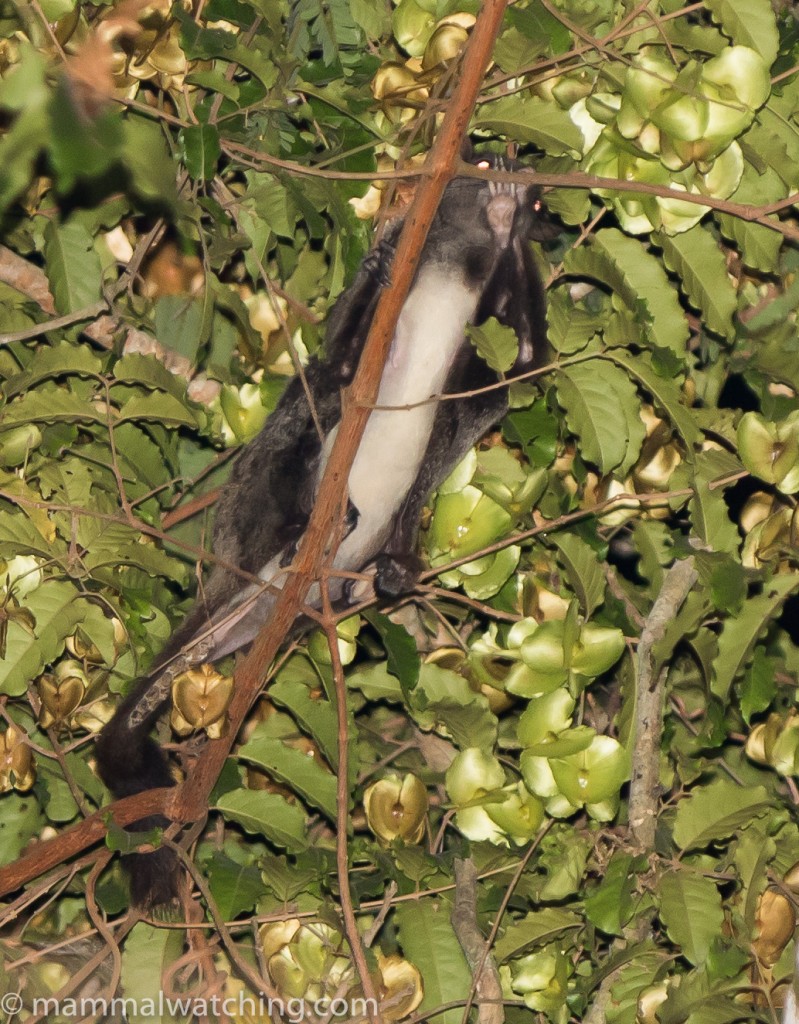
Lord Derby’s Anomalure, Anomalurus derbianus. I think.
This anomalure looks similar to the westernmost subspecies, Anomalurus pelii auzembergeri, which is not as striking as the other subspecies because it has a black, rather than white tail. However this animal was not jet black like I understand the Pel’s to be, and though the tail seems longer and bushier than that in many pictures of Lord Derby’s Anomalure, I have since seen photos of Derbianus with similar looking tails. So, after a lot of checking photographs, I think on balance of probability it is likely a Lord Derby’s Anomalure. A fabulous beast whatever it is, which didn’t seem remotely concerned about the lights we were shining at it. The scales on the underside of the top of its tail clearly visible too (hence the other common name “scaly tail”).
If anyone things differently then please let me know.

Lord Derby’s Anomalure, Anomalurus derbianus
One of the best mammals of the trip, which thankfully stuck around until Phil and Ash returned from their viper encounter.
Small Mammals
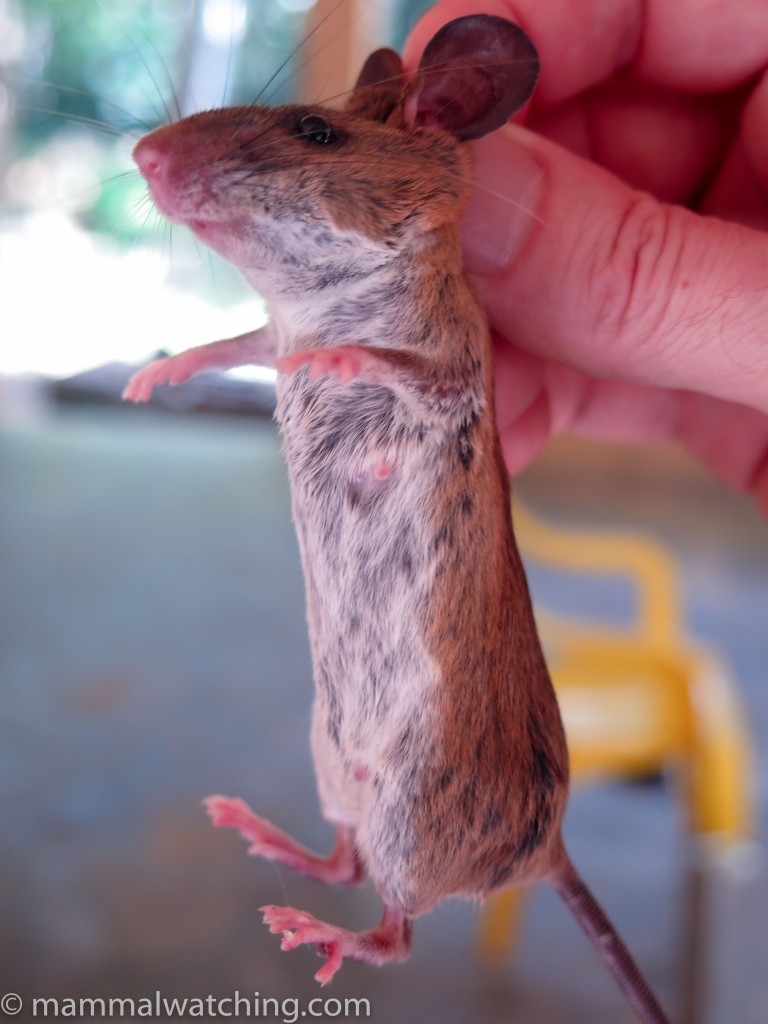
Allen’s Wood Mouse, Hylomyscus allen simus
I tried to catch small mammals in the forest. But during 80 trap nights had no luck whatsoever as is often the case for me in African rainforest. Rodents were not uncommon in the accommodation and I caught a couple of wood mice under my bed. I think they must be Allen’s Wood Mouse, Hylomyscus alleni simus which is the only species in the region, though there seems to be some discussion about whether this is a subspecies of H. alleni or a full species in its own right, H. simus.
We also got a reasonable look at a distinctively striped mouse, dark brown with a broad black dorsal stripe, running around the forest close to the accommodation at 5 p.m. This must have been Miller’s Striped Mouse, Hybomys planifrons.
Bats
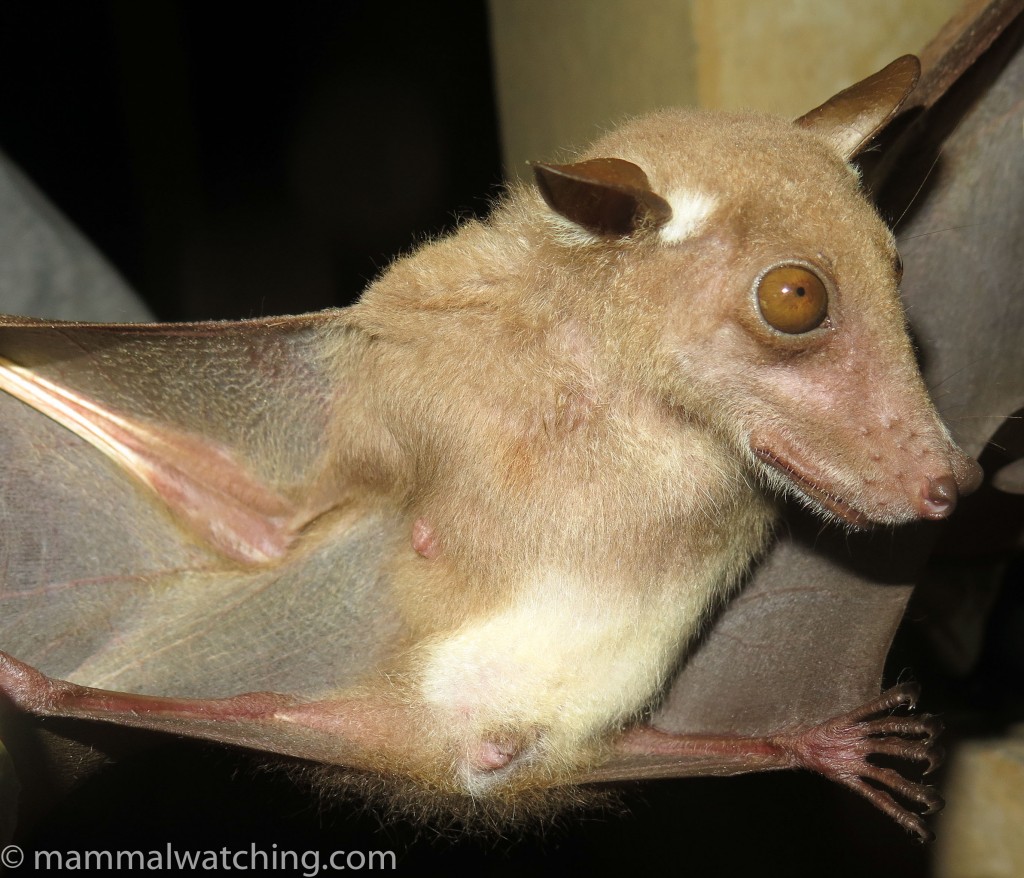
Buettikofer’s Epauletted Bat, Epomops buettikoferi
Although I would like to have spent more time catching bats, the pressures of hippo spotting meant batting took a bit of a back seat. However, we did get permission to set one net on our penultimate night, and two on our last evening (note that catching bats and small mammals is prohibited in Gola Rainforest without a permit).
We caught four bright red roundleaf bats over the two nights. The local hipposideridai are difficult to separate without genetic testing, because of several cryptic species : all seemed to be from either Noack’s Roundleaf Bat (Hipposideros ruber) or the closely related Hipposideros caffer or H. fulignosus, though it isn’t possible to know which without genetic testing (thank you Afribats!).
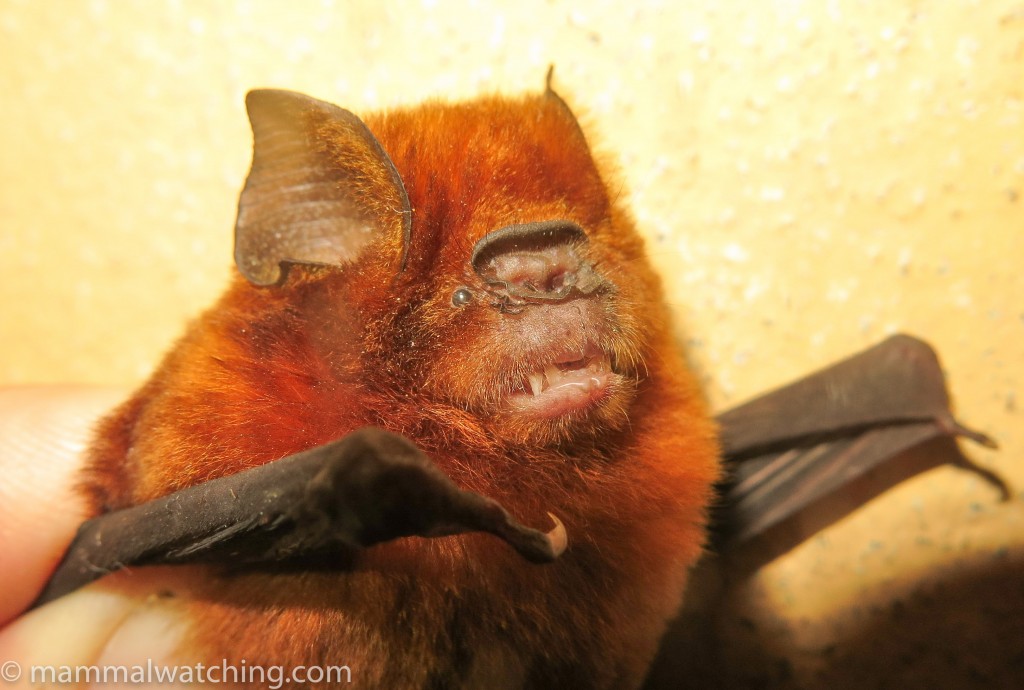
Noack’s Roundleaf Bat, Hipposideros ruber (or possibly H. caffer or H. fulignosus)
On our last evening, in a net strung alongside the river, we caught an impressive – and impressively chunky – Buettikofer’s Epauletted Bat.
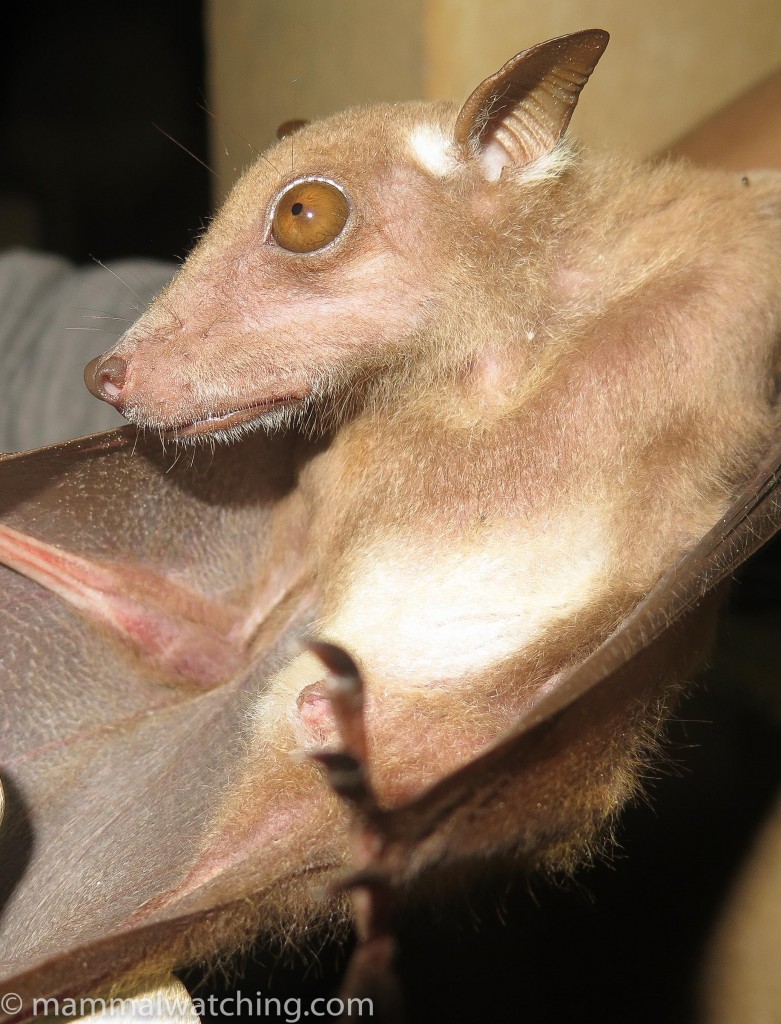
Buettikofer’s Epauletted Bat, Epomops buettikoferi
The other species was also new for all of us, one of the butterfly bats, the little know Beatrix’s Bat, Glauconycteris beatrix. Its identify was rapidly – and very helpfully – confirmed by the good people at Afribats.
I really must plug Afribats work here and try to encourage all of us to submit interesting records of African bats to them. It doesn’t take more than a couple of minutes, they will give rapid advice and – if a sighting can be verified – it will be accepted as “research grade” which is good for science and good for mammalwatching.
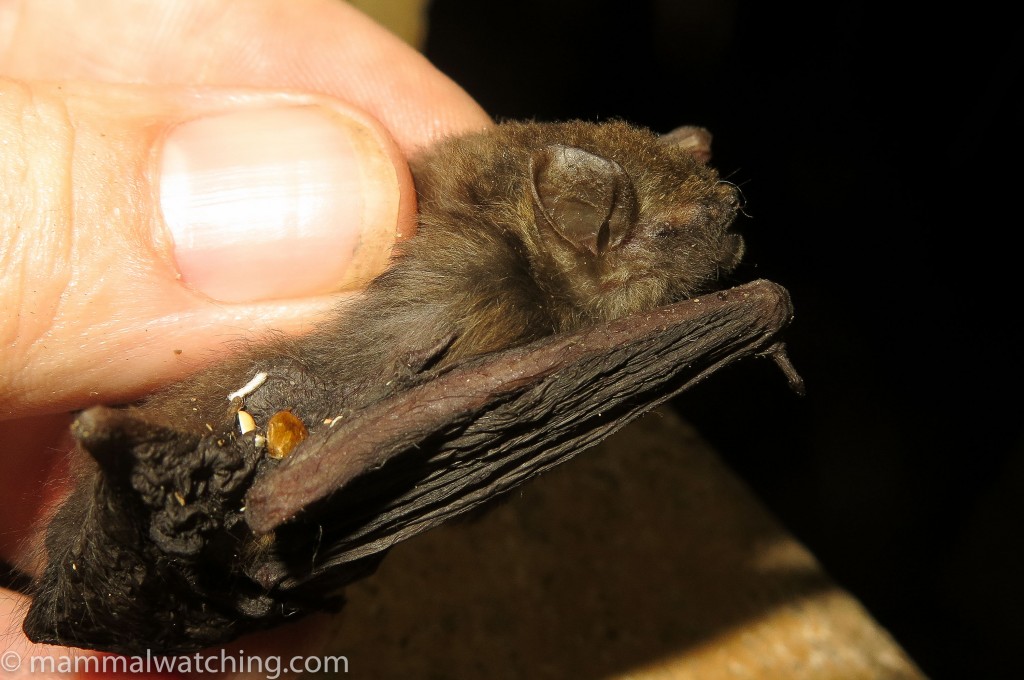
Beatrix’s Bat, Glauconycteris beatrix
Along the river at night there were enormous numbers of bats both skimming the water as well as squadrons of Straw-coloured Fruit Bats streaming high over the river at dusk (the thermal scope helped us to pick up one feeding in a tree).
I saw several small fruit bats along forest trails at night but didn’t get a photo of any of them so I cannot ID them. A horseshoe bat was using the research station kitchen as a night roost. I only thought to check this building on the last night and the bat flew the coop when I disturbed and did not return so I couldn’t photograph or identify it.
Squirrels
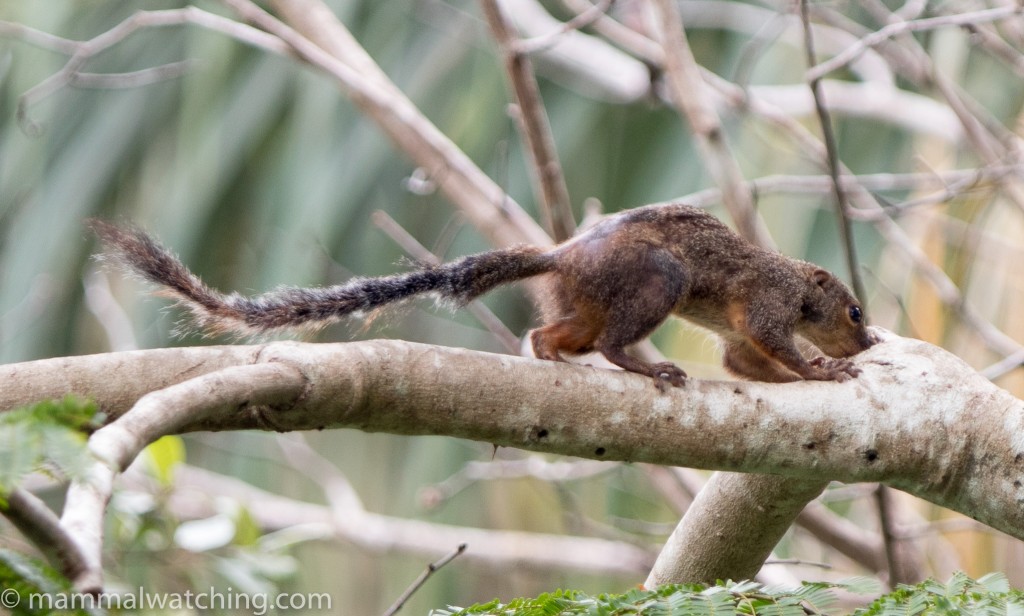
Red-legged Sun Squirrel, Heliosciurus rufobrachium. No sured what happened to the bushiness of its tail….
We saw dozens of squirrels. We got conclusive views of a handful. More often than not we’d see a blur of motion in a tree and then shadowy views of small parts of an animal darting through the foliage. Pelage colours often changed drastically when an animal came into direct light.
That said, Red-legged Sun Squirrels were around the accommodation and we had confirmed views of several animals during our stay, together with at least one Gambian Sun Squirrel and what were almost certain several Green Squirrels though no one got quite enough of a view to be certain.
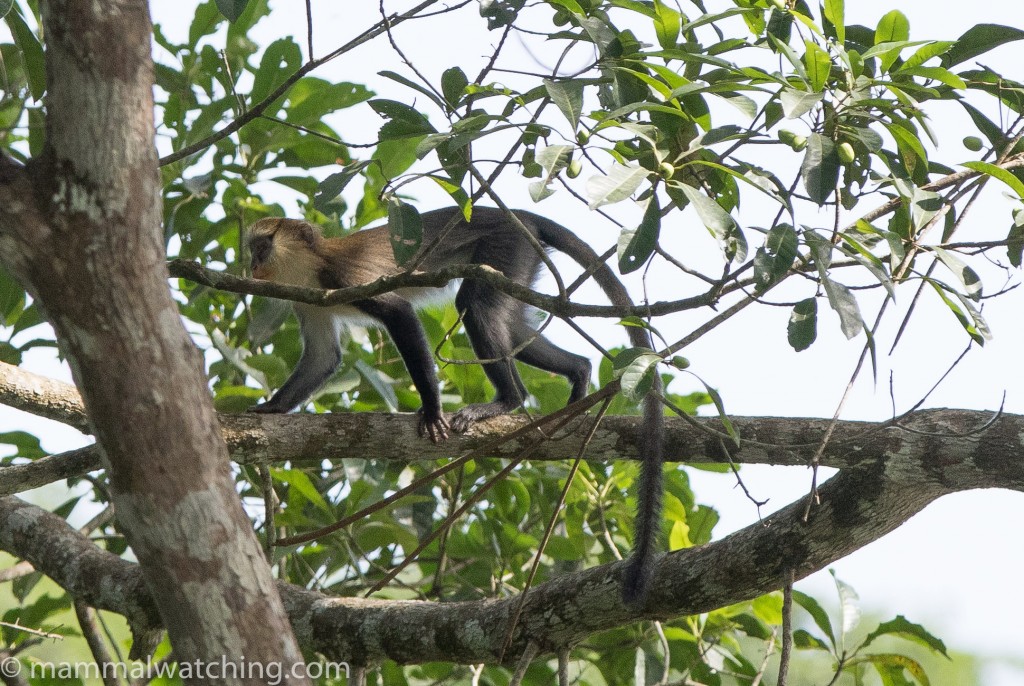
Campbell’s Monkey, Cercopithecus campbelli
After four nights we had seen 23 species, more than half of which were new for me. But we had not gotten very close to a Pygmy Hippo and didn’t have much faith in the “hope we bump into one” strategy we had pursued so far. We were optimistic that Gola Rainforest, our next destination, would give us a more tangible focus for our hippo hunt.
Gola Rainforest National Park
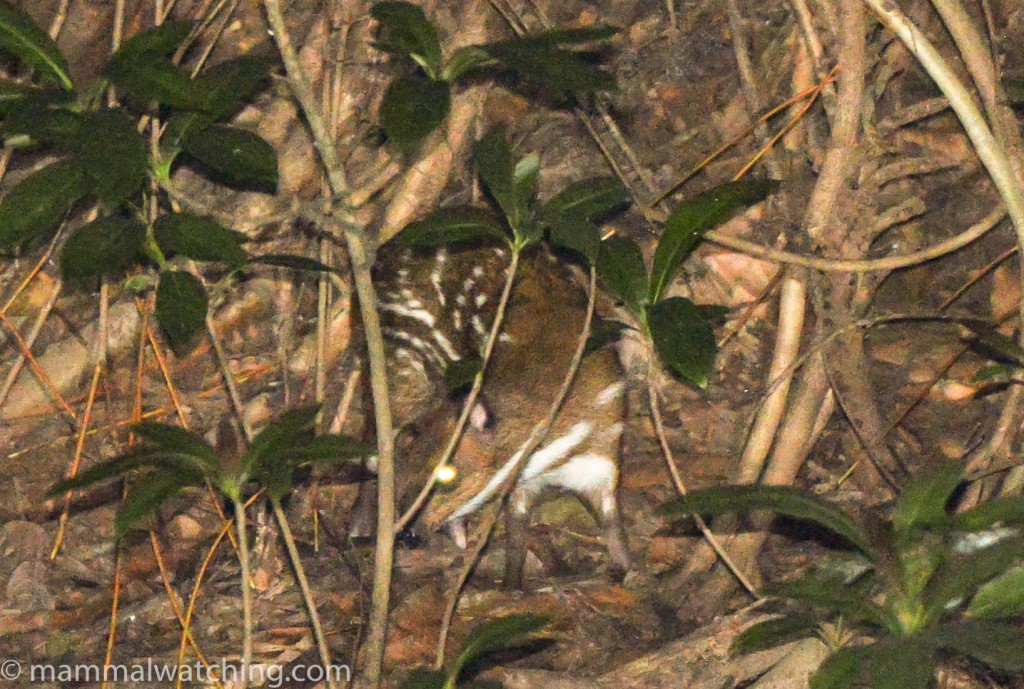
Water Chevrotain, Hyemoschus aquaticus. Photo by Phil Telfer.
It is a mere 14 miles from Tiwai Island to Gola’s Sileti Substation as the hippo trots. But there is no road, and it took six hours driving a long, bumpy – and almost complete – circle to get there.
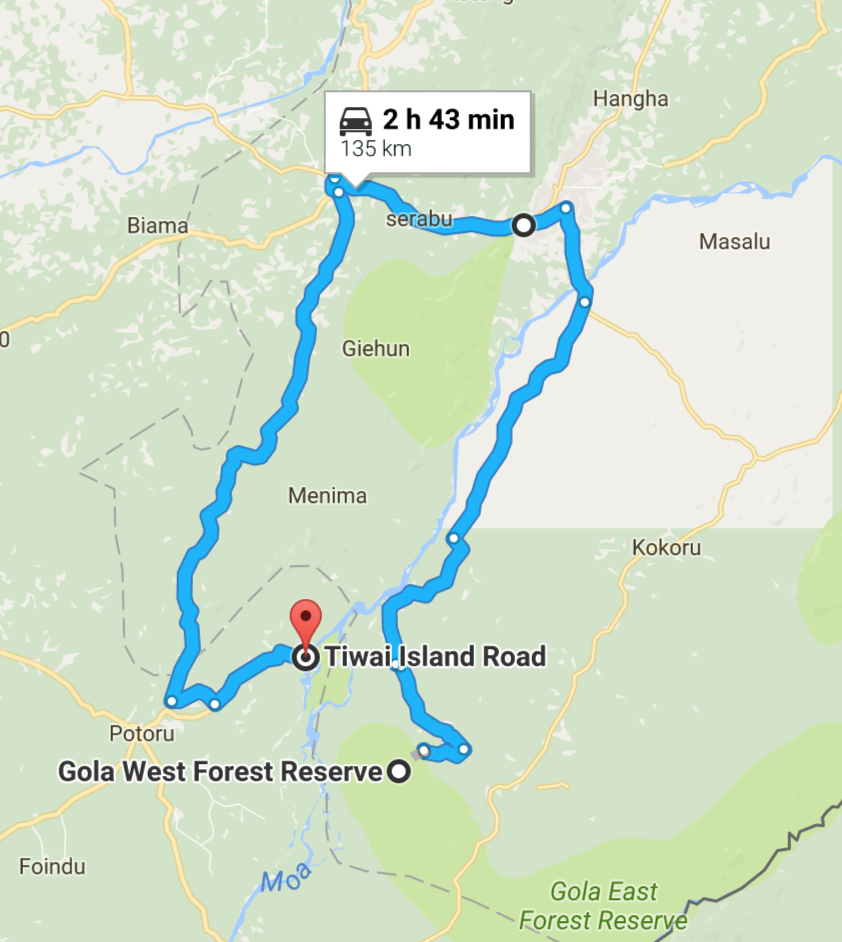
Taiwan Island to Gola Rainforest, more or less …..
Our first stop was the Gola Rainforest Park Office in the town of Kenema where we met Benjamin Barca and Pietro Sandini, the RSPB appointed scientists, in the office. They had organized our visit, answered our many questions and loaned us books and research papers, and were clearly very keen we enjoy our visit.
We hit up the Kenema supermarket for cold drinks, snacks and – joy of joys – an ice cream (I am not sure any ice cream has ever tasted better anywhere). And then we were on the final 2.5 hour – extremely bumpy – road to the Sileti Substation in the southern part of Gola. This road must be pretty much impassable in the wet.
Sileti Substation
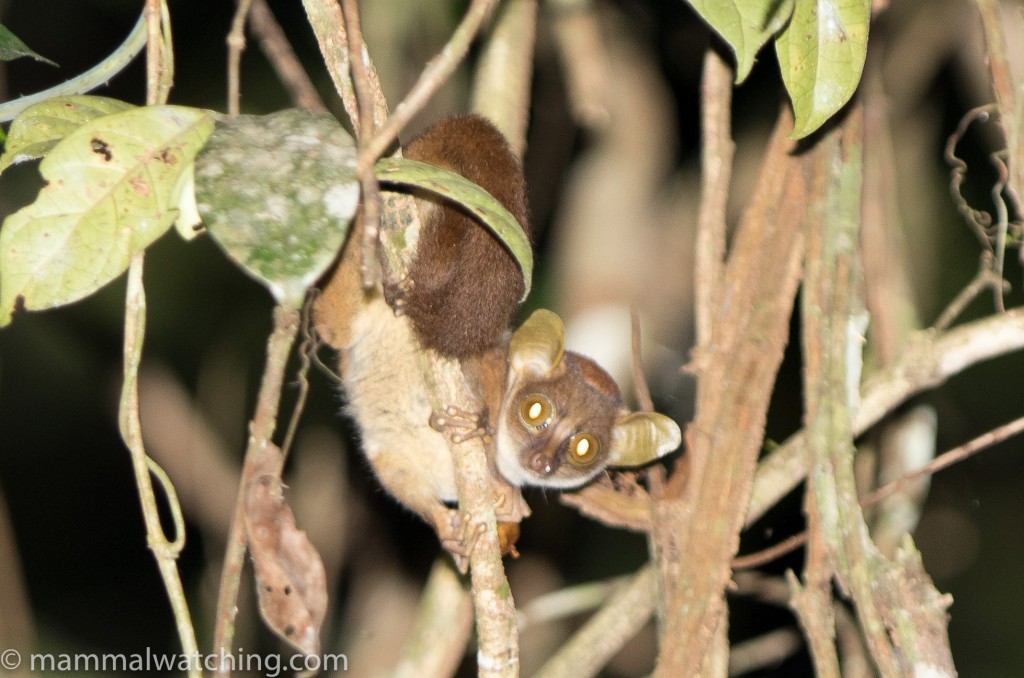
Demidoff’s Galago, Galagoides demidoff
We spent three nights at the substation on the edge of the park, before and after our camping expedition. It is potentially a rich area for mammals, with Bongos among the species seen or camera trapped nearby. On the first evening we spotlit up and down the road to the substation and saw both Demidoff’s and Thomas’s Galagos in quick succession.
The Demidoff’s Galago was only 3 metres up a tree, the Thomas’s much higher. We heard them both calling (the call is quite different and a useful call library is here) so were sure about our ID even though the two species are virtually identical to look at.
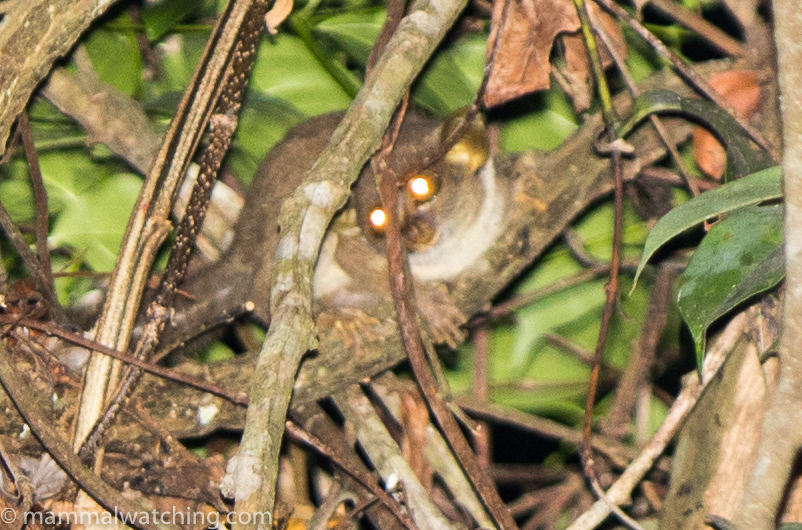
Thomas’s Galago, Galagoides thomasi
I kept on walking after the others went to bed, and flushed a tiny Royal Antelope from the roadside immediately past the driveway to the research station. My first thought was I’d seen a Madagascar Giant Jumping Rat: the animal had a curious hopping gait as it bounced across the road. I would love to have had a better view but suspect the sighting I had was about as good as I could expect. Although we all looked again for the animal we didn’t succeed, though the staff at the substation said “Yes, that one walks here” when I showed them the picture in the book.
We headed off deeper into the park the next morning, but returned to Sileti three nights later.
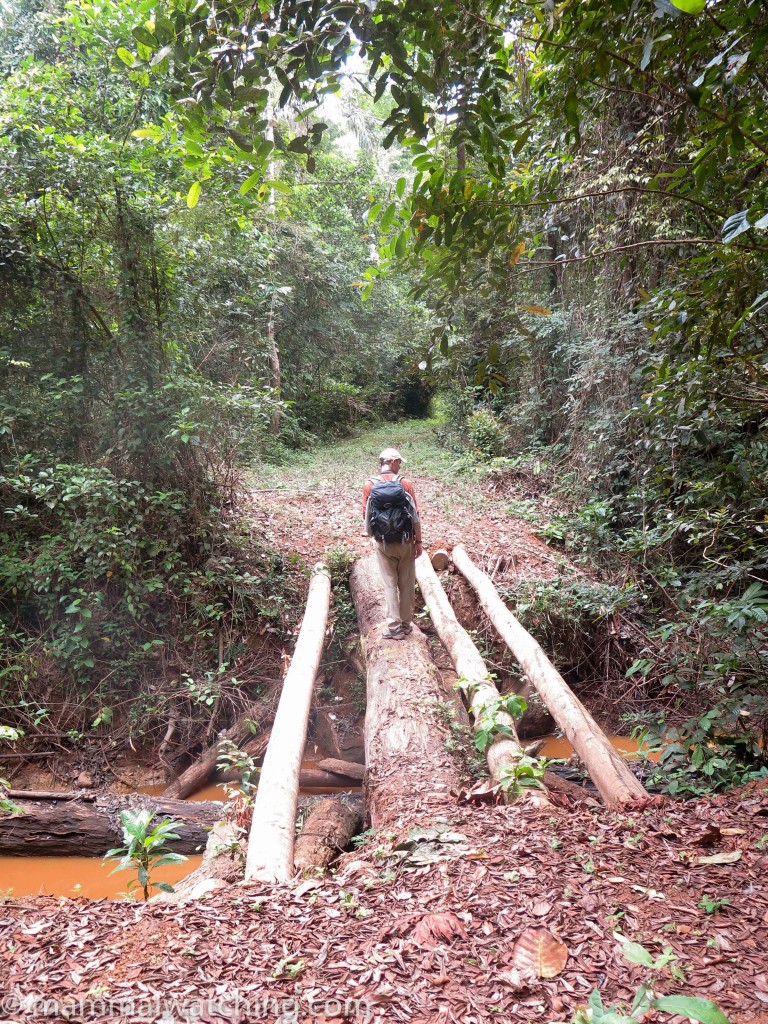
Log bridge on the Mahoi Road
When I returned I walked along the first mile or two of the trail and old road that leads from the substation towards Mahoi Bridge: twice at dusk and once at dawn. The mammal watching was slow but rewarding.
Just after dark one evening, and moments before a heavy rain shower, I saw my first Western Tree Hyrax in the fork of a tree on the edge of a clearing near the station. I have heard dozens of tree hyraxes, including all around Sileti Lodge, but it is a species that is maddeningly hard to find despite the racous call.
I had been told that tree hyraxes didn’t have eyeshine. This one did, though was very quick to avoid the light despite the beam being turned down low, and moved into the foliage whenever the light hit it. I suspect it might have been easier to see than usual because it had moved down low in a tree to avoid the rain.
Early on my last morning I saw my first duiker of the trip, a Maxwell’s Duiker, along the road to Mahoi Bridge (just after the first log bridge). I froze when I heard rustling and watched it start to emerge from the forest before it made eye contact with me. Shortly afterwards I spotted a distinctive Slender-tailed Squirrel half way up a tree, its call a “guk guk guk” (think chicken with laryngitis). I wasn’t carrying my camera unfortunately.
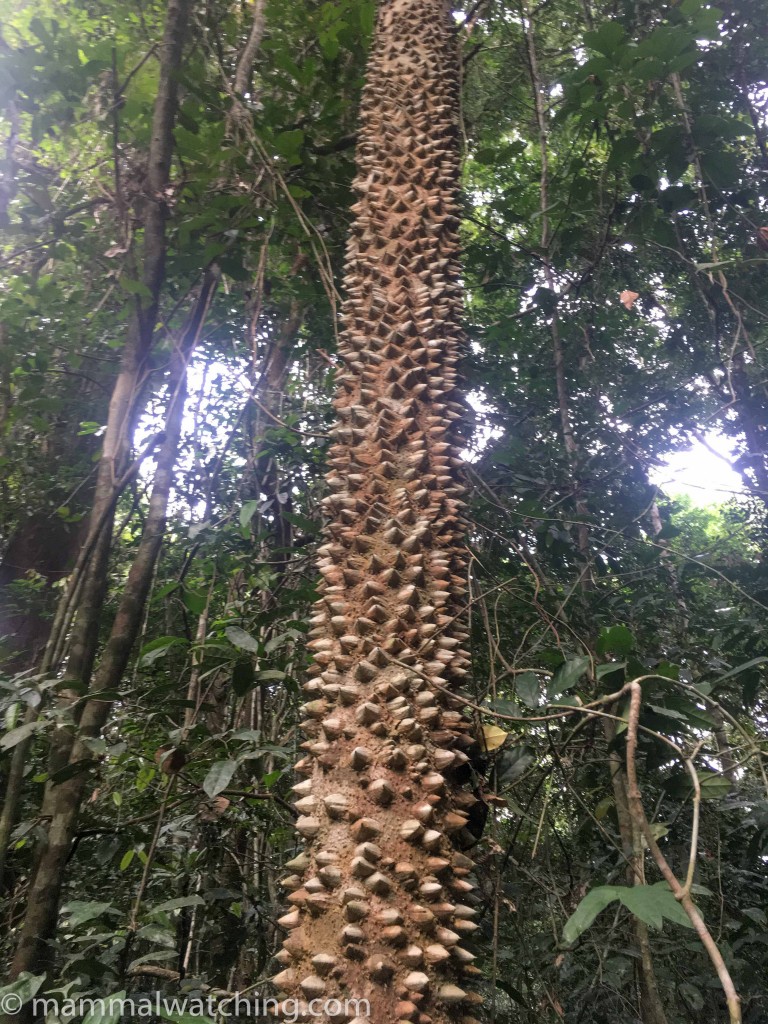
A Yellow-backed Duiker had also been spotted twice in successive days along the same stretch of the Mahoi Road: once by a porter and once by Phil and Ash. Charles and I set off in search of it on our last afternoon and got a brief look at the back half of the beast jumping into the forest from the roadside where it had been grazing (annoyingly we had stopped just 3 metres short of a perfect view to scan the trail when the animal saw us and bolted). Definitely one for my “Want better views” list.
We decided to sit down and wait in the hope the duiker returned. It didn’t, but after 15 minutes another Maxwell’s Duiker emerged from the forest. Sitting and waiting might be the best spot for seeing Duikers, and the staff there said Bay Duiker were not uncommon, occasionally seeing Zebra Duiker too.
On our last night we drove into the local village for dinner and a beer and spotlighting along the road was productive (more productive than in the forest in fact) with several West African Pottos and an African Palm Civet.
Mahoi Bridge
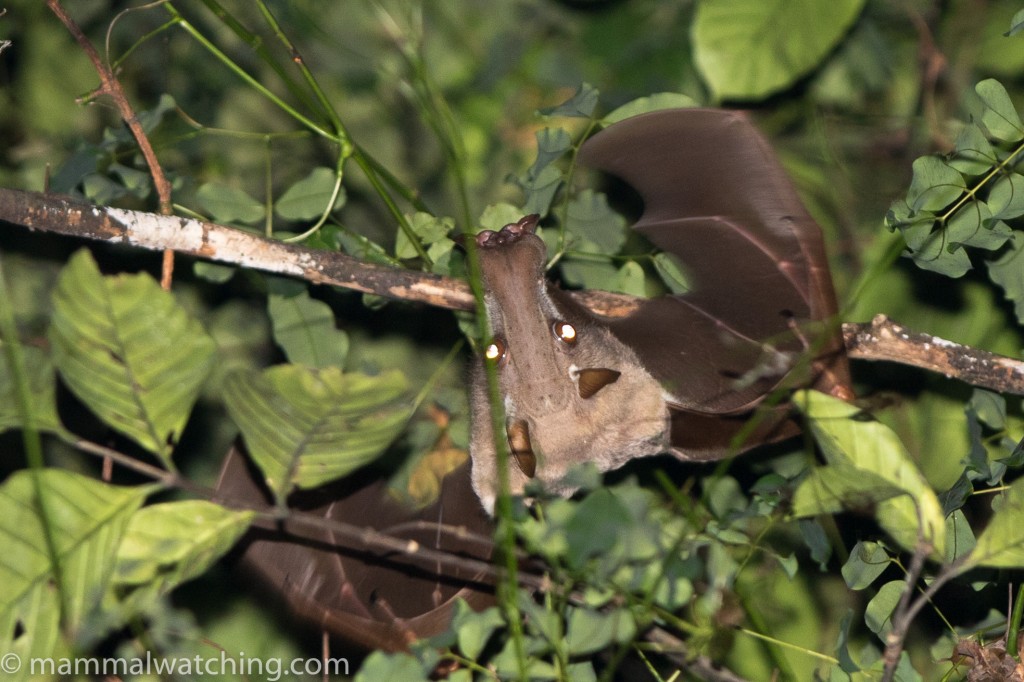
Hammer-headed Fruit Bat, Hypsignathus monstrosus
We had planned to spend most of our time in Gola camping at Mahoi Bridge, a six mile walk from Sileti. The park, we were told, had established a salt lick here, and it was here that Ben Schweinhart had heard a hippo.
It was quite the expedition to transport our luggage, and all the food and camping gear that the park had provided, to the bridge: our convoy comprised eight porters, four research technicians, and the four of us.
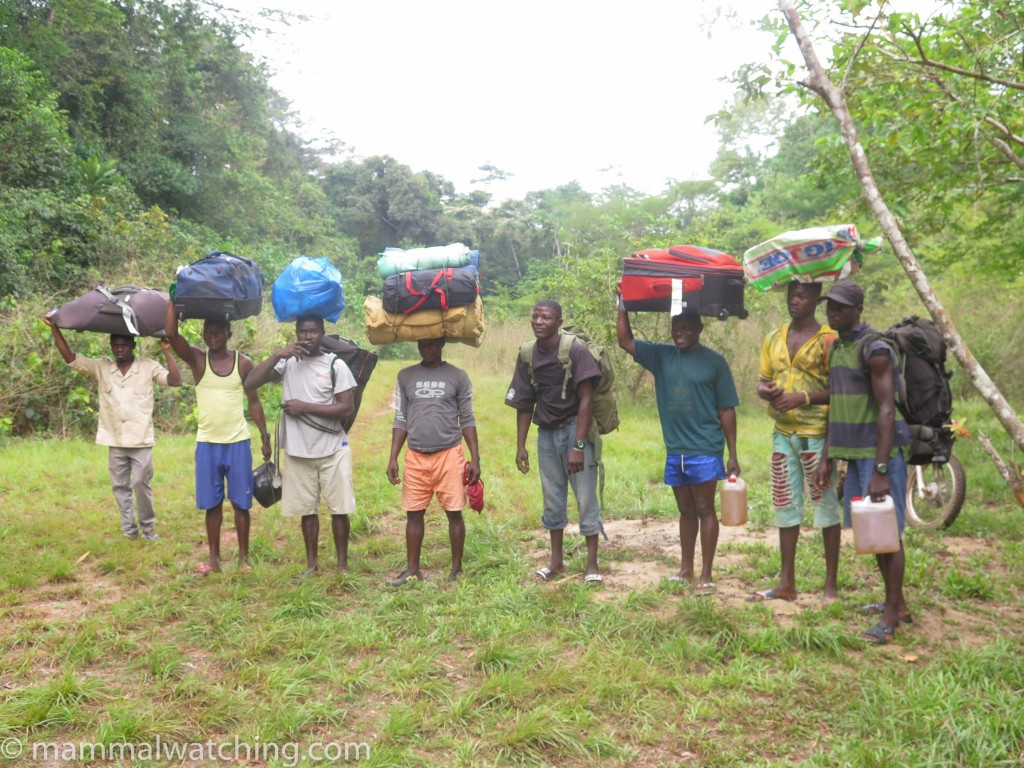
Gola porters
The three hour walk from the substation begins with a kilometre or so of forest trail, at which point we joined an abandoned logging road that leads to Mahoi Bridge, spanning the Moa River. The road, occasionally cleared by a tractor, sees no other vehicles and seemed to offer a much better chance for encountering wildlife than the forest tracks we had been using so far. Although the forest had been logged, there were plenty of enormous trees left, so the logging had been selective. And if it wasn’t for the logging I guess the area might well have been cleared for agriculture.
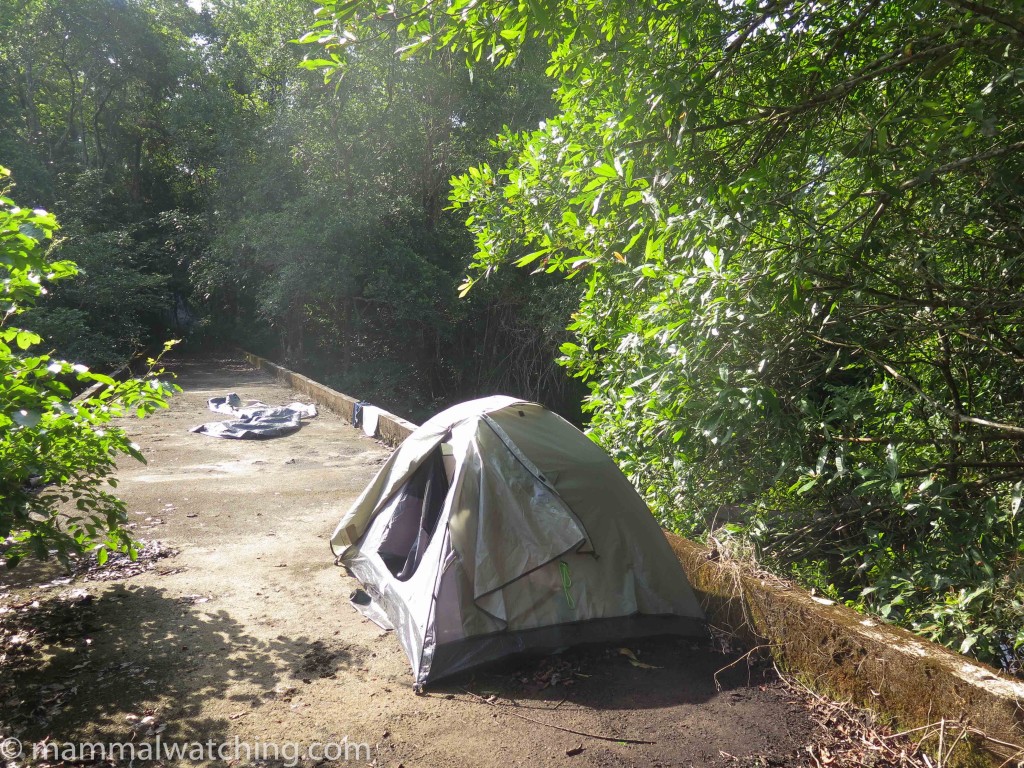
Mahoi Bridge campsite
The bridge was an impressively hunk of concrete, and as soon as we had pitched our tents on top of it we went to inspect the salt lick. Our hippo optimism quickly evaporated: there was no sign of any recent activity around the lick and the guides told us that the only tracks we could see belonged to the animal that Ben had heard three months earlier. This was a real blow.
We did have a back up plan though. When we had visited the office in Kenema, Benjamin had told us of another area, along one of the park’s primate transects (T8), where a hippo had been seen recently. We resolved to shift camp there the next day, and dispatched two of the technicians immediately to search for fresh hippo tracks.

Moa River, Gola
But, hippos aside, we were excited to be at Mahoi Bridge because it was home to a Hammer Bat lek. A species we had heard in Tiwai, but which none of us had seen.
Not only are Hammer-headed Fruit Bats the largest bat in Africa, with a wingspan of around 3 feet, but they are arguably one of the most interesting bats in the world. The males gather in trees to form “leks” where they call incessantly through the night trying to attract females. Jonathan Kingdon described the male as a “flying loudspeaker” because their bizarre call carries for many kilometres. I loved them just for their latin name Hypsignathus monstrosus, probably something to do with their size but possibly because they are thought to be one of several bat species that carry Ebola.
We knew the lek was somewhere by the bridge and were a little worried about finding it until 15 minutes after sunset when the air was very quickly filled with sounds of lekking hammer bats. An extraordinary noise (check out this video) with twenty or so bats hanging from the trees on both sides of the bridge. A very special experience.
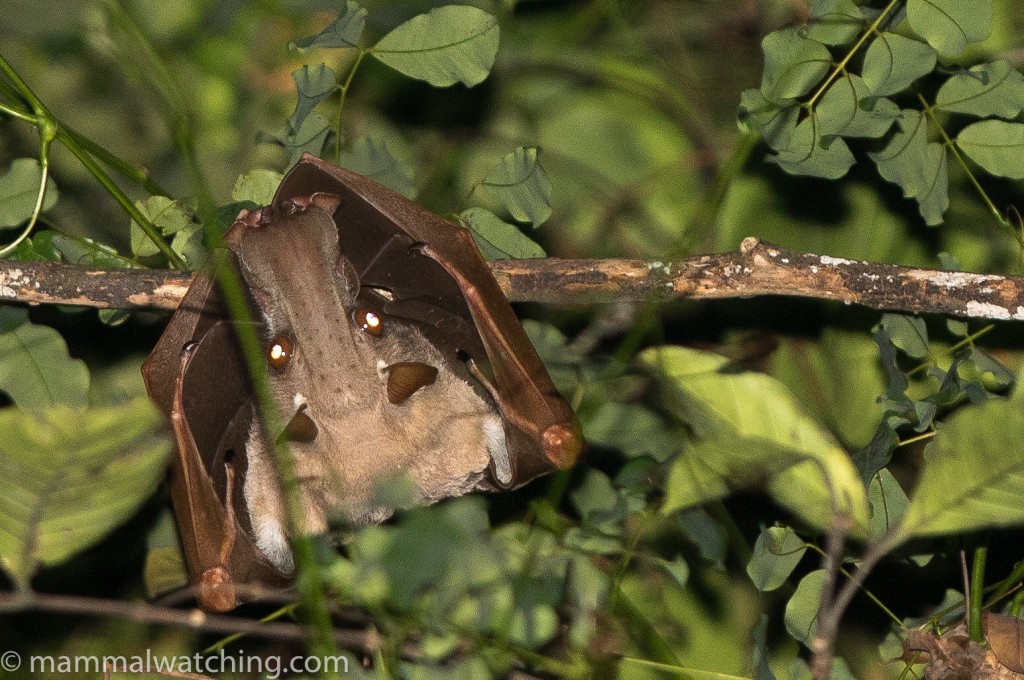
Hammer-headed Bat, Hypsignathus monstrosus
Phil and Ash walked that evening with one of the guides and saw a Maxwell’s Duiker. Charles and I hung out at the bridge, scanning the river and walking the trail alone. We didn’t see anything and then torrential rain put a stop to the evening at 9 p.m. I am not sure the bats lulled me to sleep but somehow their racket didn’t keep us awake.
Gola T8 Transect
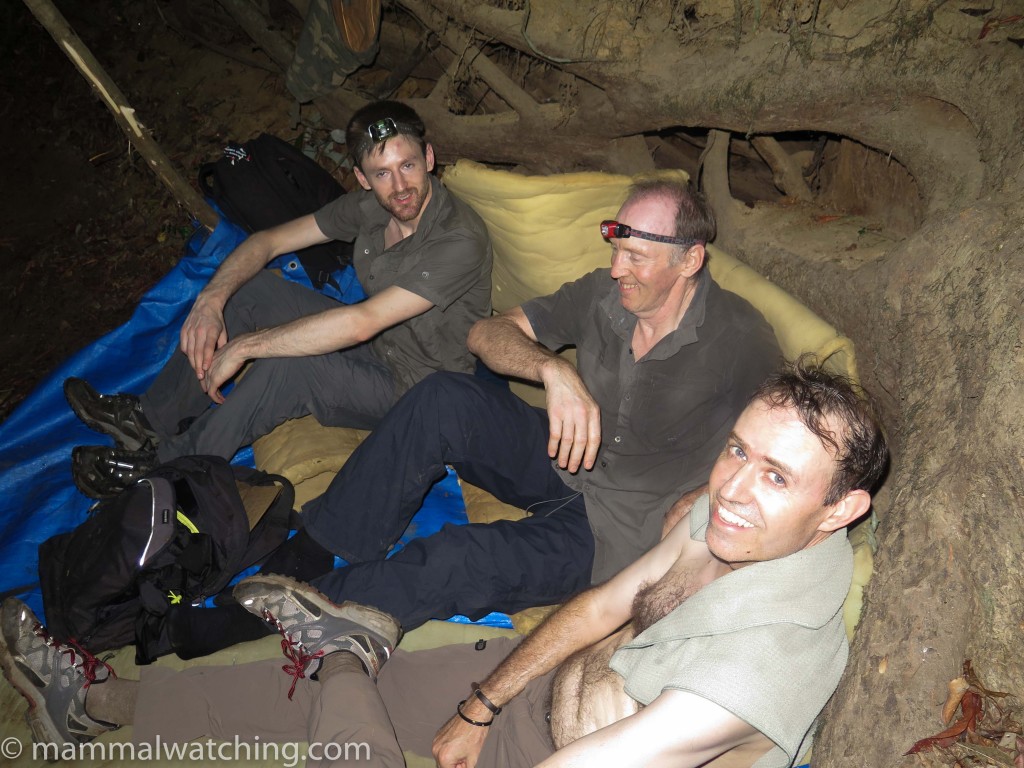
Hippo stakeout
The T8 primate transect crosses the Mahoi Road about an hour from the bridge, back towards Sileti Substation. From there it was a 20 minute hike along a barely formed trail down to the Moa River.
After a much needed swim we went in search of hippo sign, and quickly established that at least one animal was using the area, with fresh tracks on just about every “entry point” along the river for several hundred metres from camp. Hippos cannot climb up steep river banks, and move from the river into the forest (where they feed at night) using entry points where the bank is low or collapsed.
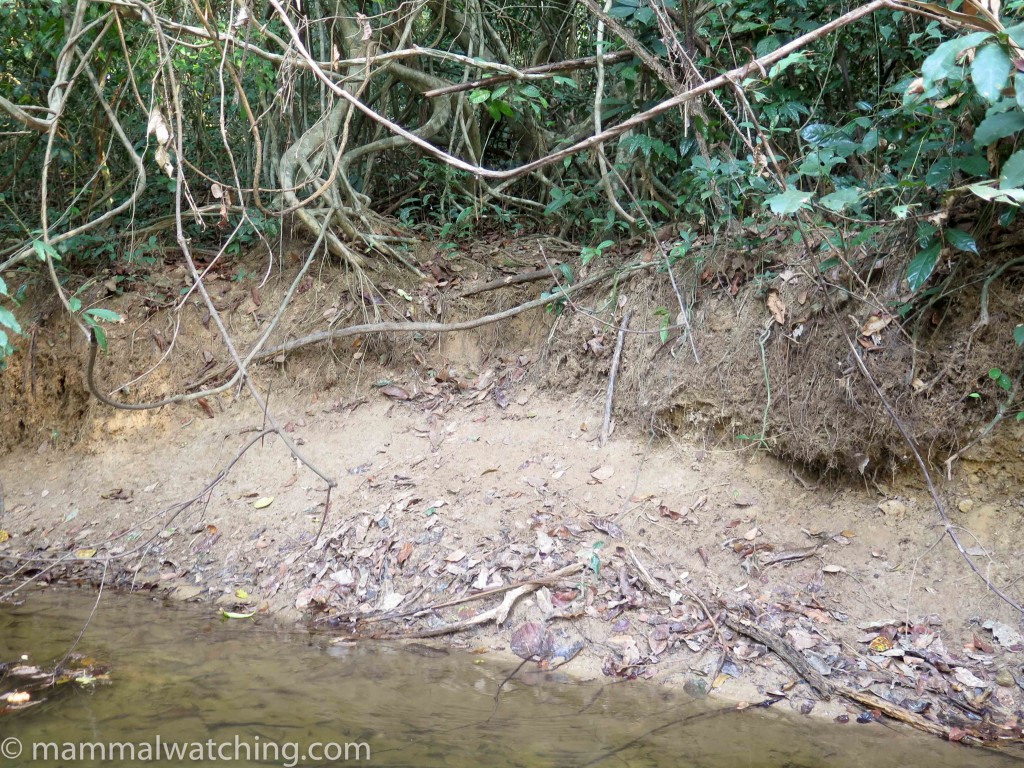
Hippo entry point
We planned to stake out a likely looking area at night, using my new thermal imaging scope, and couldn’t decide whether to pick a vantage point that offered a view of a decent stretch of the river, or a spot that was 20 metres into the forest and offered a view of the forest floor that hippo(s) seemed to be feeding on. Either was a gamble as the animal(s) had a large area of forest and river to choose from and at best we could cover a tiny segment. In the end the Telfers found a place that gave us the best of both worlds: a seat on the river bank where we could see up the river for 50 metres but that also had a view of at least two entry points.
So we threw down some foam mattresses, tried to ignore the legions of saucer-sized spiders under the tree roots behind us and prepared for an uncomfortable night. Tonight was the first time I had used my new thermal imaging scope in earnest. I will write a review of this soon, but while it has its weaknesses in some situations, using it here was a real strength. Pygmy Hippos are so secretive, and so wary from hunting pressure, that I am pretty much certain they would bolt at the first sign of a spotlight.
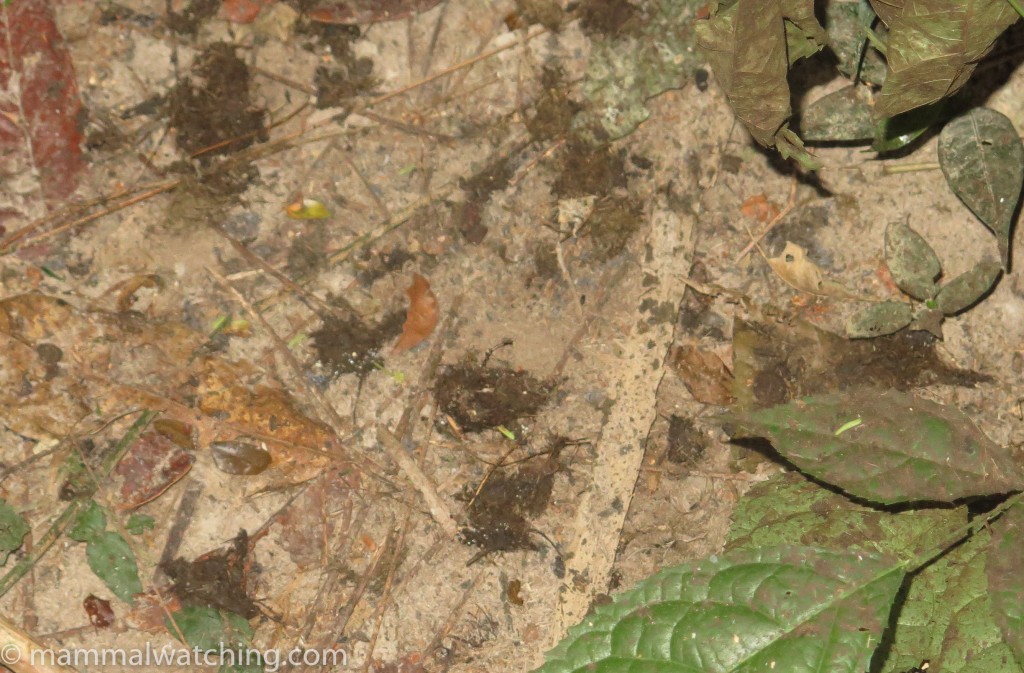
Hip-poo
The other three headed to bed at midnight but – unlike them – I had managed to nap amongst the spiders, so was able to stay up all night. I figured I would hear a hippo in any case if one was close. As the night wore on I scanned with the scope less often.
Using the scope I saw mice and rats running in trees across the bank, several galagos and what I think must have been an African Palm Civet. But no hippo.
Just after sunrise the next morning I saw (initially found with the scope) this mysterious squirrel in a palm tree.Jane Widness got in touch and persuaded me it was indeed an African Giant Squirrel.
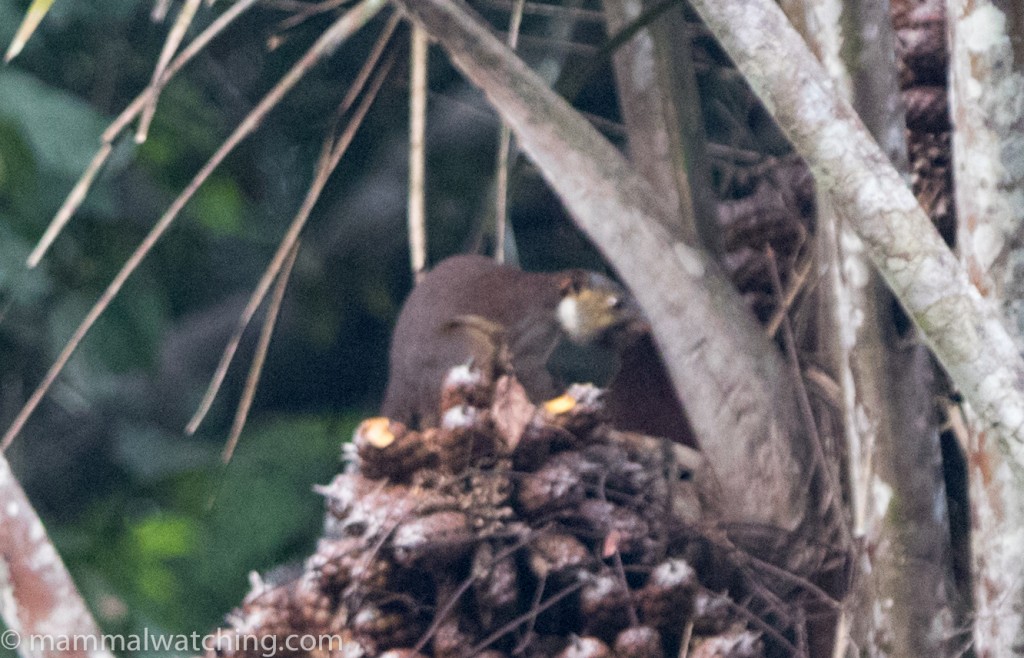
African Giant Squirrel, Protoxerus stangeri
Our spirits were dampened the next morning, not helped by the fact we realised that none of us had packed any loo paper. Bear Grylls eat your heart out.
I slept most of the day, while Phil and Ash found a few Fire-footed Rope Squirrels running around a tree root. We took an evening walk back to Mahoi Road where we heard monkeys and distant Chimpanzee plus a large sounder of Red River Hogs very close to the road. Once again we couldn’t see them.
I had wanted to stay up all night again for the hippo, but when the others talked about a night walk to look for pangolins, a fear of missing out kicked in and I decided to join them. But in the late afternoon Charles had a run in with a hairy caterpillar and when his neck started to blister he decided to bail on the walk in favour of a hippo watch. With my fear of missing out pulled in two directions the hippo won easily. So Phil and Ash headed out for a walk and Charles and I returned to the foam mattresses at the Hippo Hilton.
I will turn now to Charle’s account of what happened next because he captures the moment perfectly.
Jon and I had been sitting quietly watching and listening for an hour or so when we heard a splash in the distance and Jon started scanning that part of the river. After a while he said ‘There is something moving in the river. I think it’s a Pygmy hippo.’ Heart pumping madly, I looked through the thermal imager, and for a while couldn’t see much except for a white blob in the river which looked like any other rock; except that suddenly this rock started moving against the current, then lifted its head and flicked its ears. A real, live, Pygmy hippo! I couldn’t believe it!
In a state of slight shock, we quickly agreed not to use the torch until it had climbed onto the bank, suspecting, (correctly as it turned out) that it might disappear once it saw the light. The hippo moved noiselessly downstream, investigating little side tributaries, and we lost it for a minute or so. I scanned the bank with the imager and suddenly there it was, standing on the opposite bank of the river some 30 yards from us. Jon had a quick glance through the scanner, we readied our equipment, and then I lit it up with a very high intensity torch beam. It was darker and larger than I was expecting – about the size of a mid-sized calf – but unmistakably hippo-shaped. The animal swung around to face us, froze for about one second looking at the beam, and then plunged into the river. Its head popped up a few meters upstream, but then it went down again and that was the last we saw of it.
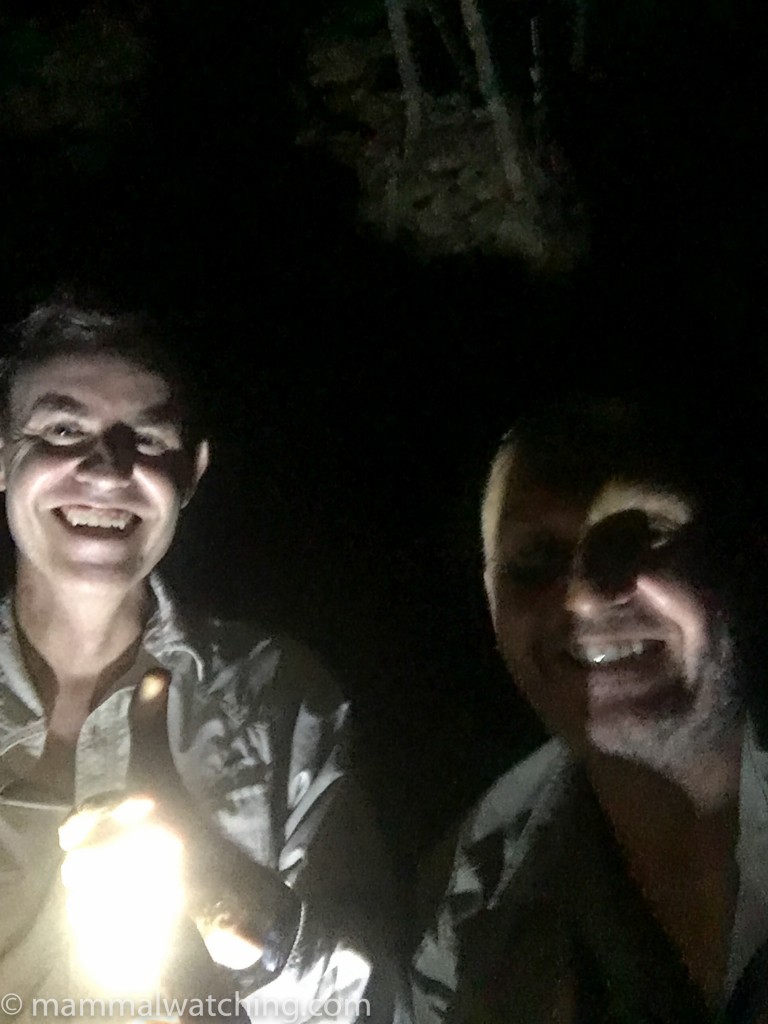
Hippos R Us
Absolute elation; high fives, fist pumps, and lots of rich language. We had seen a live, wild, honest-to-God Pygmy hippo, one of the rarest, most secretive large mammals on the planet. The constant sweating, the frustratingly poor visibility in the forest, and the 10 days of eating nothing but rice with peanut sauce drenched in palm oil were all forgotten. Our view with the torch light had lasted less than two seconds, but we didn’t care – tonight we were Kings of the world!
Cue this short jubilant video. We realised the next day that the animal had been coming out to feed just 30 metres from our campsite.
Our thoughts turned to Phil and Ash. We felt terrible that they had missed it, but they took the news on the chin when they got back from a mammal-less walk just 45 minutes later.
Charles and Ash headed to bed but Phil wanted to stay up and I kept him company, eventually crawling into the revoltingly hot (and pretty revolting all round) tent on the bank just above our look out.
At 4 a.m Phil whispered something about a Water Chevrotain and a minute later I was looking at one of the prettiest mammals I have ever seen. I know very few people who have seen this tiny antelope, an absolute gem of a beast, with extremely bright green eyeshine, that moved in and out of the undergrowth on the river bank for a good 15 minutes.
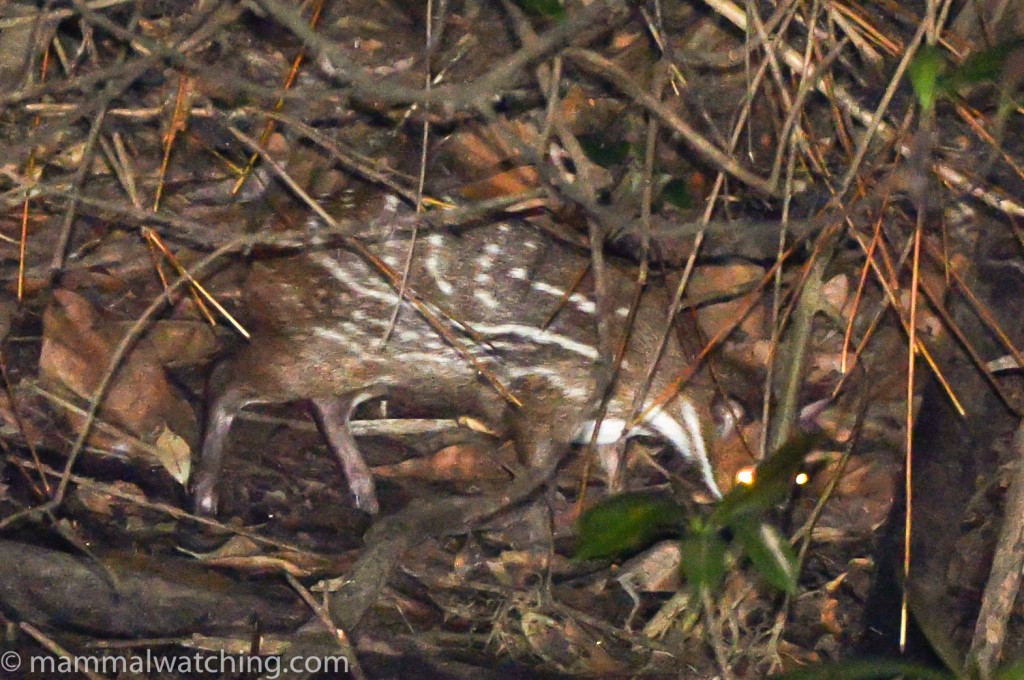
Water Chevrotain, Hyemoschus aquatics. Photo by Phil Telfer
Phil had already been looking at it for 20 minutes before he called me and had taken some decent pictures. Although initially wary of the light it no longer seemed concerned.
Phil had had a busy night, seeing multiple rodents through the scope and even a snake swimming across the river. But no hippo.
The next morning we returned to Sileti Lodge for much needed showers. Charles and I spent the night there, but Phil and Ash returned to the hippo spot for one more try. Torrential rain stopped play at midnight, and though they didn’t see a Pygmy Hippo they did see a Yellow-backed Duiker on the walk in.
Final Thoughts
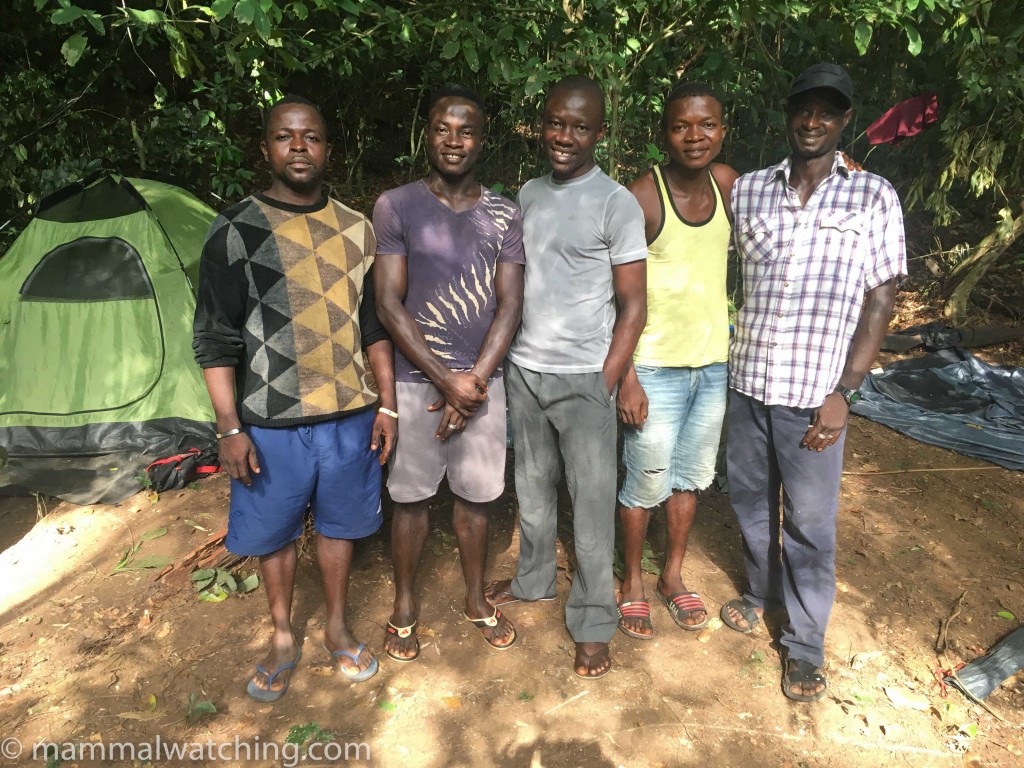
The road crew: from left to right, Mohammed Kawa, Mohammed V Sheriff, Nazie Sesay, Mohammed B Nyallay, Salou Sow.
What a trip! Certainly not the easiest or most comfortable I have taken but one of the most memorable. A week later I am still dreaming every night that I am back in the forest. The mammals aside, we were blown away by the friendliness and all round niceness of the people we worked with, especially Alusine in Tiwai, Benjamin and Pietro at the RSPB in Gola, and our research technicians/ camp managers in Gola (above). Thank you all so much.
And, more than ever, I sincerely hope our report will inspire others to visit. Not only because I know you will have a good time, but because of all the benefits a visit can bring to the local community and wildlife. This is a real chance for the mammalwatching world to help conservation efforts.
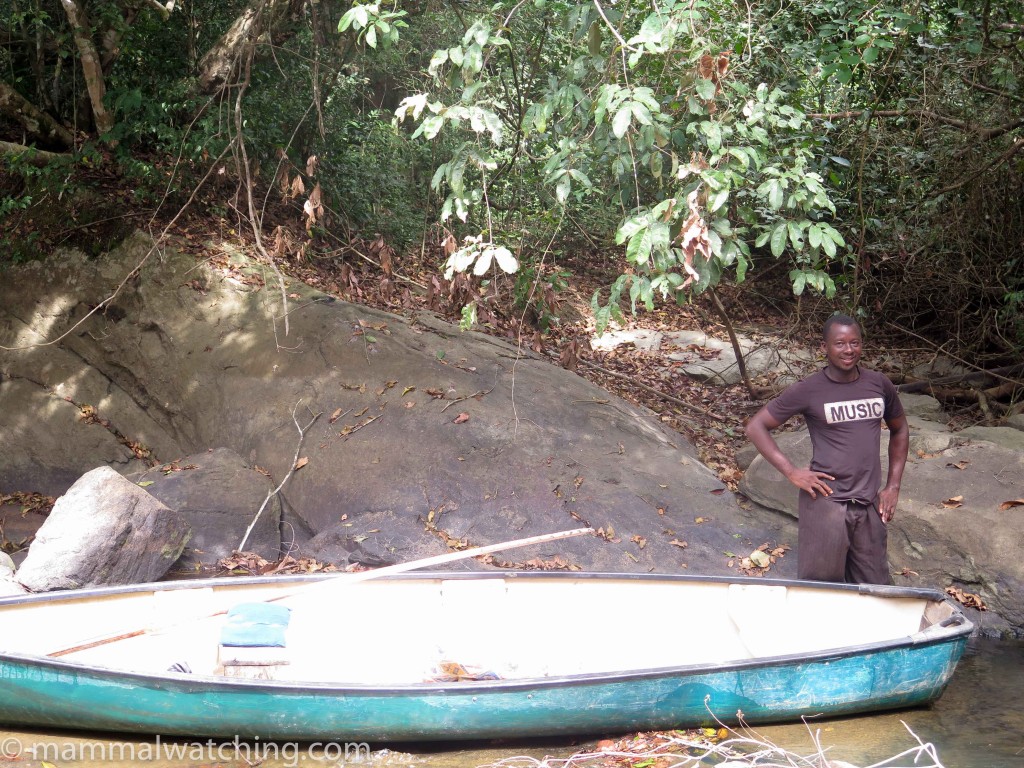 Alusine
Alusine
As an aside I was also taken aback that news of the new US President had reached the Gola Rainforest, and our guides, quite well informed, were not sure whether to be amused or concerned about him. If you can make it there, you can make it anywhere….
There is clearly enormous potential for mammal watching in both Tiwai and Gola, hippos aside. Tiwai is a primate watcher’s wet dream, while Gola offers much better than usual chances of some great ungulates, White-bellied Pangolins and more. It would be even better if they set up some feeding spots to attract duikers and other ungulates.
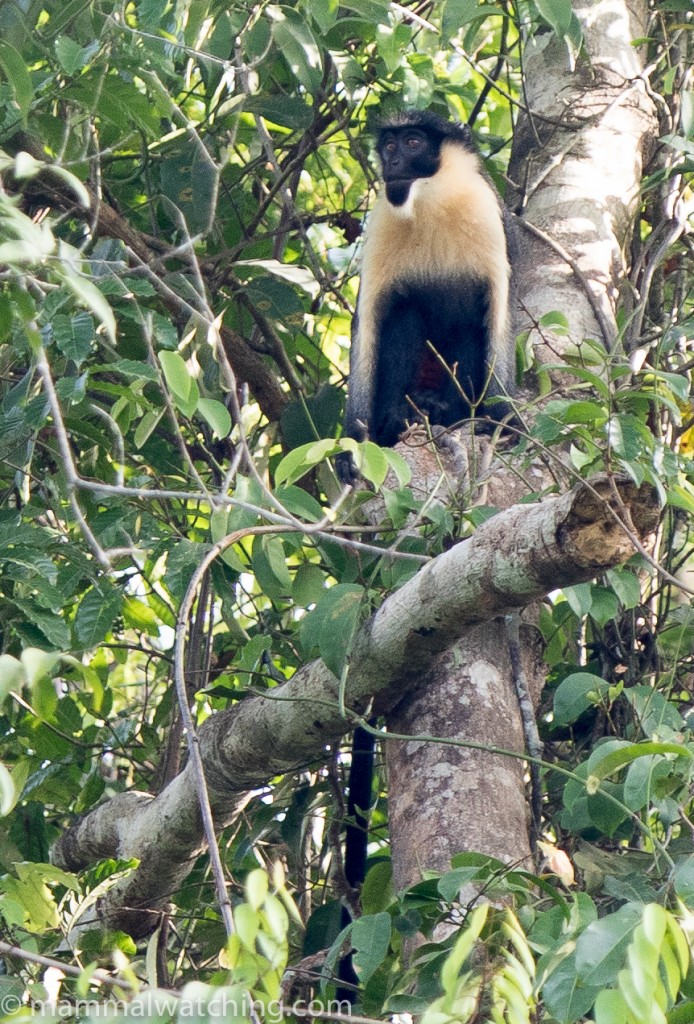
Diana Monkey, Cercopithecus diana
None of us was under any illusion that seeing a hippo was going to be easy, but I’m very glad I didn’t find out ahead of time how hard it had proven in the past. April Conway was researching Pygmy Hippos on Tiwai Island a few years ago and spent seven months looking before she saw one. Worse, we heard of another hippo researcher spending 5 years in Gola Rainforest National Park without seeing an animal.
We may, of course, have been spectacularly lucky to see a Pygmy Hippo but I am sure the thermal imager increased our chances hugely. I had assumed that the hippos would, at least, be easy to hear. But our animal was essentially noiseless as it cruised down the river and climbed onto the ban.
If I was returning to Tiwai I would request that Alusine sets up some salt licks a week or so before I arrived so I could consider staking out any that were being regularly used. I would also spend more time on the river at night with the motorboat.
Gola has an advantage in that a large team monitor the park and know where the fresh hippo activity is. If I returned I would ask the park to scout out areas with very recent sign a couple of days before I arrived and head straight there (though a night at Malhoi Bridge is a must too).
Perhaps, more important than anything, is a belief in the impossible and a good deal of patience (skills which can be sharpened any time you phone the Expedia.Com help desk).
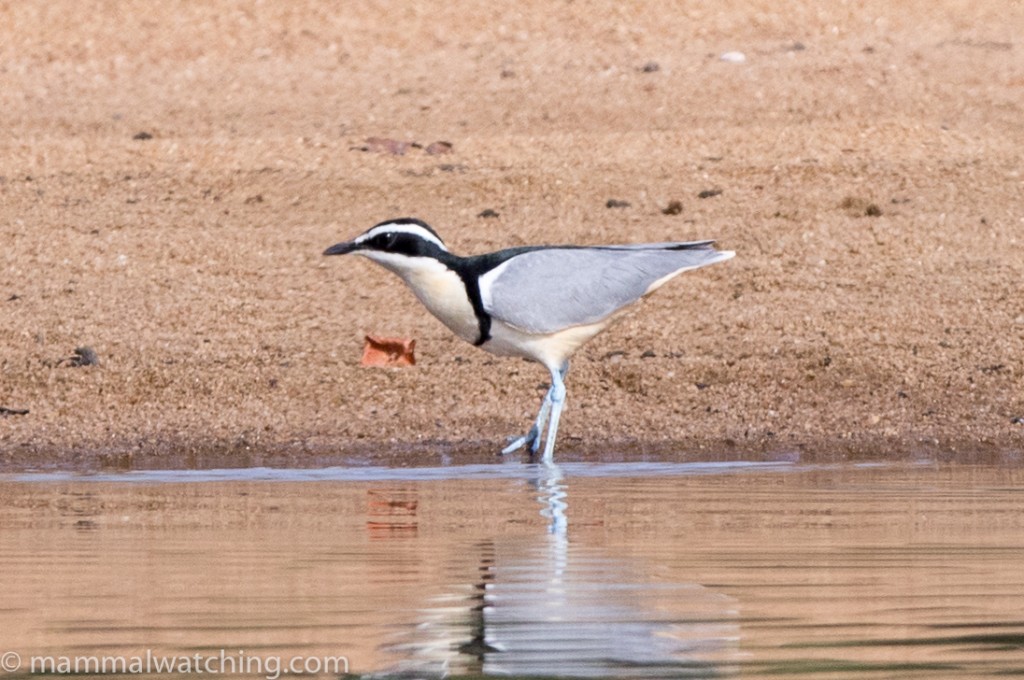
Egyptian Plover, Tiwai Island. A good bird apparently.
A final thank you to Tobi and Ben for their trail blazing trip reports, particularly to Ben for all his advice in the lead-up to our trip. And thank you too to my travelling companions Charles, Phil and Ash: if I was ever again planning to spend a week without toilet paper in 95% humidity, I would want to be with you!
Stuff We Missed
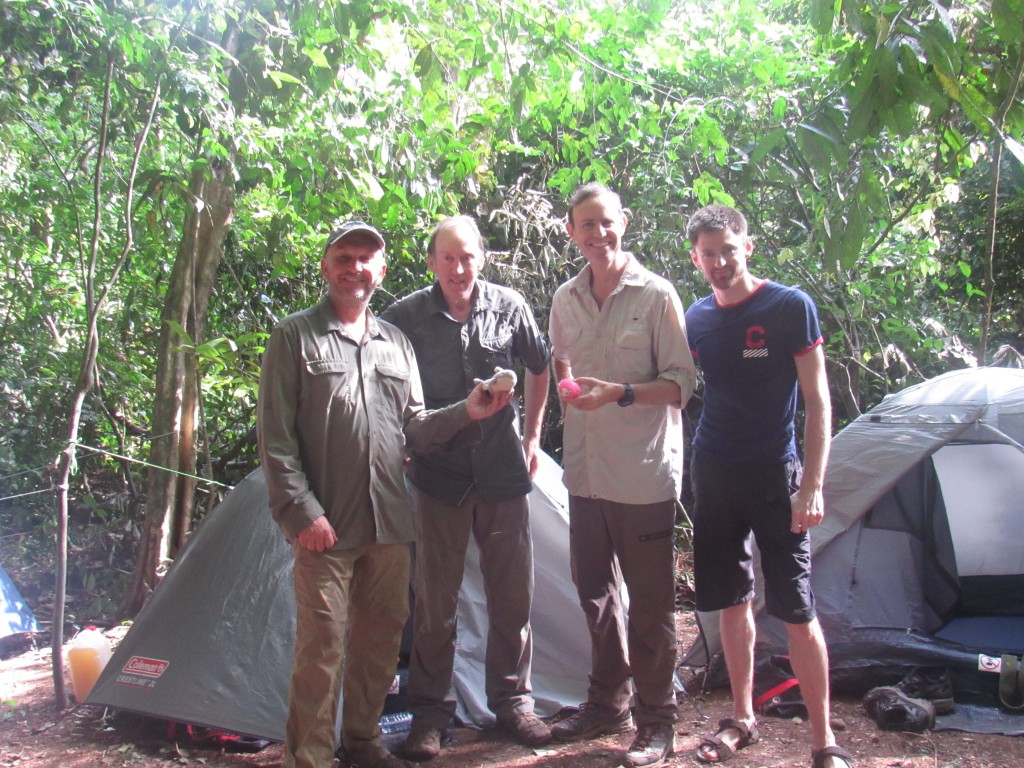
Me, Phil, Charles and Ash. Plus lucky mascots from the Foley girls.
We did pretty well between us but Ben and Tobi both recorded species we didn’t. White-bellied Pangolins were high on everyone’s wish lists. Ben saw a couple in two weeks and I suspect if we had spent more time walking trails, and less time on or by the river, we might have been successful. Beecroft’s Anomalure are apparently not uncommon, nor are Bay Duikers. There was a slim chance of Zebra Duiker and Bongo, and a much slimmer chance of Jetink’s Duiker and Giant Pangolin. There are presumably several other duikers there, in addition to Yellow-backed and Maxwell’s (both of which we saw). Black Duikers for instance are not uncommon we were told, while Ogilby’s Duiker is present but more elusive.
Trip List
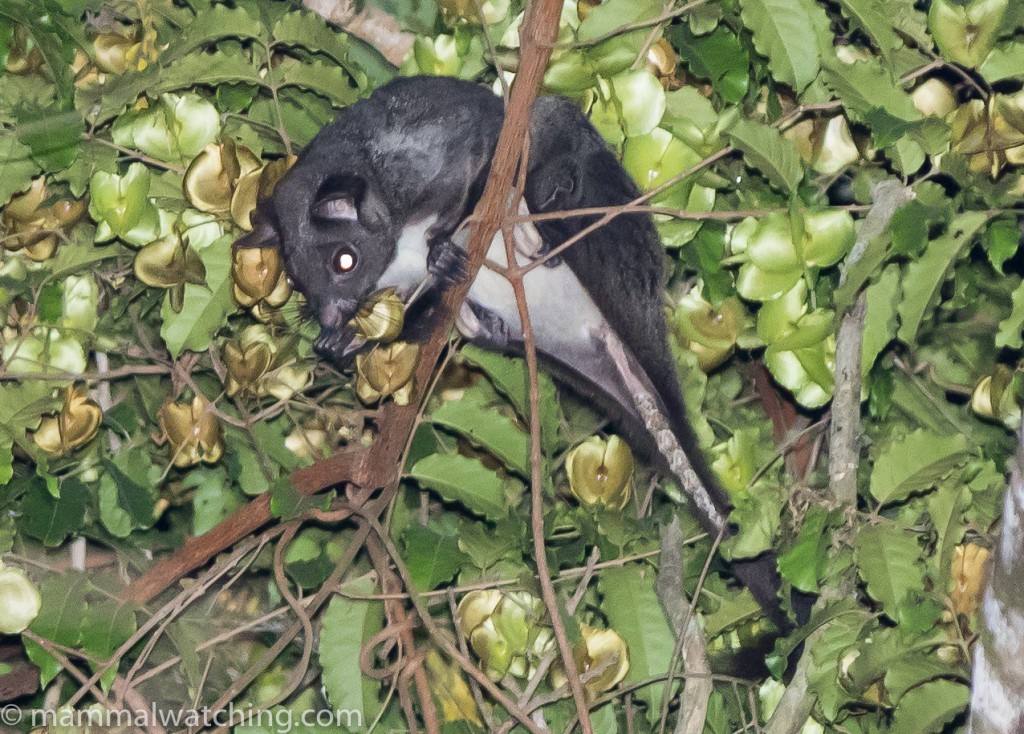
Lord Derby’s Anomalure, Anomalurus derbianus.
Key: Species prefixed with an F are lifers for me. T = Tiwai, S = Sileti area (Gola), M = Mahoi Bridge (Gola), G = elsewhere in Gola.
Starred species * were not seen by me
Striped Ground Squirrel Xerus erythropus (en route between Tiwai and Gola)
Fire-footed Rope Squirrel Funisciurus pyrropus G*
F Gambian Sun Squirrel Heliosciurus gambianus T
Red-legged Sun Squirrel Heliosciurus rufobrachium T
F Slender-tailed Squirrel Protoxerus aubinnii S
African Giant Squirrel Protoxerus stangeri M*
Green Bush Squirrel Paraders poensis T, Lungi Airport Hotel
F Miller’s Striped Mouse Hybomys planifrons T
F Allen’s Wood Mouse Hylomyscus alleni T
F Lord Derby’s Scaly-tailed Squirrel Anomalurus derbianus T
African Palm Civet Nandinia binotata G, S
Straw-colored Fruit Bat Eidolon helum T
F Hammer-headed Fruit Bat Hypsignathus monstrosus M
F Buettikofer’s Epauletted Bat Epomops buettikoferi T
Noack’s Roundleaf Bat Hipposideros ruber (and/or H. caffer/ H fulignosus) T
Unidentified Horseshoe Bat T
F Beatrix’s Bat Glauconycteris beatrix T
Demidoff’s Galago Galagoides demidoff T
Thomas’ Galago Galagoides thomasi T, S
Potto Perodicticus potto T, S
F Western Pied Colobus Colobus polykomos T, S
F Western Red Colobus Piliocolobus badius T
Olive Colobus Procolobus verus T
F Sooty Mangabey Cercocebus atys T
F Campbell’s Monkey Cercopithecus campbelli T, S
F Diana Monkey Cercopithecus diana T, S
Lesser Spot-nosed Monkey Cercopithecus petaurista T
F Green Monkey Chlorocebus sabaeus T
F Pygmy Hippopotamus Hexaprotodon liberiensis G
Red River Hog Potamochoerus porcus T*
F Water Chevrotain Hyemoschus aquaticus G
F Royal Antelope Neotragus pygmaeus S
F Maxwell’s Duiker Cephalophus maxwellii M, S
F Yellow-backed Duiker Cephalophus silvicultor S
F Western Tree Hyrax Dendrohyrax dorsalis S
35 species
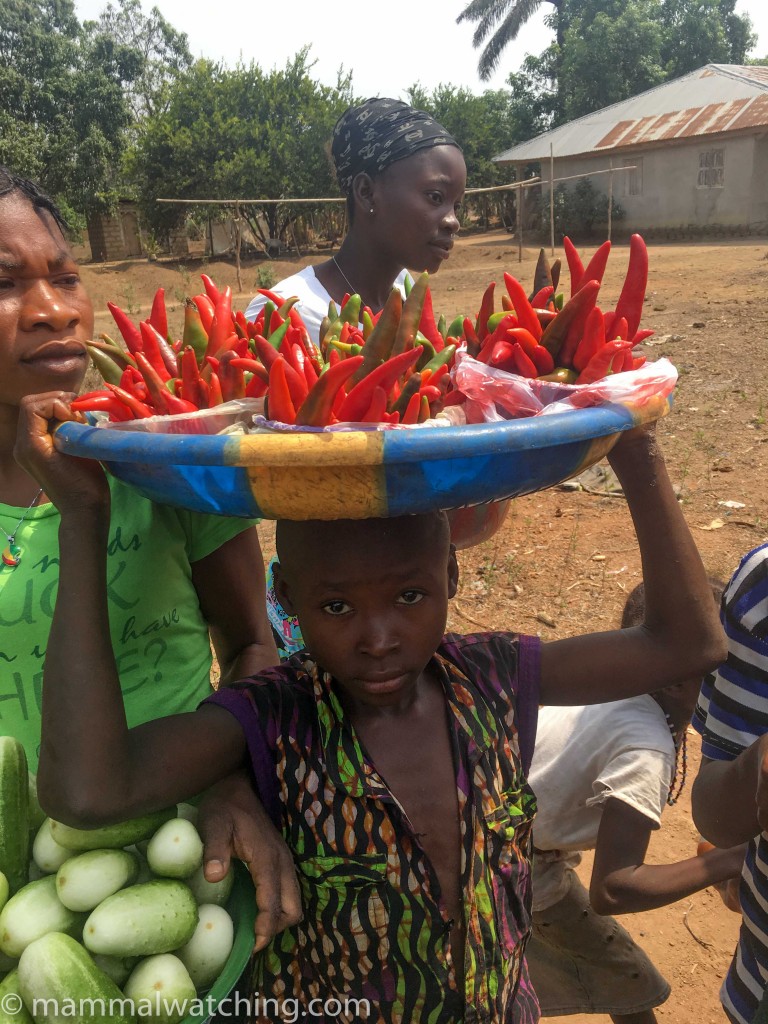
Fast food on the road to Gola
18 Comments
-
-
Vladimir Dinets
Impressive indeed! I’m particularly envious of the royal antelope.
I once had a chance to spend some time around a pygmy hippo in a zoo and found that it didn’t seem to mind red light – something to consider for people who can’t afford a thermal imager. Red light also works well for tree hyraxes.
Catching zero rodents in 80 trap-nights is also an achievement, but I’ve done better 🙂 I once spent a few days in Darien NP and caught nothing in 100 trap-nights, even though the forest was teeming with rodents and I would see 5-6 species every night by spotlighting. -
tomeslice
Jon, great report!!!!
You saw some awesome-looking monkeys, and of course the water chevrotain and the royal antelope!! That’s really fantastic. It’s also interesting to read that the red river hogs are “so common” in Tiwai island. I’ll have to keep that in mind for my next trip to West Africa (though the list of places to visit before then is still quite long).
Anyway, really cool stuff!!! Very happy for you about the hippo.
Perhaps it sounds like, from both your trip report and my trip report from the CAR, that sometimes just sitting quietly and waiting for animals to show up can be more productive than walking the narrow trails of the rain forest. I will definitely take on this strategy more often from now on 🙂
-
AfriBats
Thanks for the kind shout-out, Jon, your contributions to the AfriBats project on iNaturalist are appreciated, and everybody contributing bat observations would be most welcome. Our iNat project is focussed on African bats, but mammal observations from around the globe can be shared with iNaturalist.
To increase links b/w Mammal Watching & iNaturalist, I’m posting a link to Jon’s mammal obs from SL shared with iNat here:
http://www.inaturalist.org/observations?place_id=7487&subview=grid&user_id=jonhall100 -
geomalia
Awesome trip report! I am very jealous of the Hippo sighting, and will have to head back to Gola sometime soon to try again. Also, great job on getting your report out so quickly. I should really expedite mine, but processing photos slowly allows me to relive the memories. I’m about halfway done now. Here are a few comments:
1. The tiny flies that hang out by the river are the carriers of River Blindness/Onchocerciasis. It is unclear whether it is present in the region, and the staff at Gola NP told me that it wasn’t there. However, I would still recommend a preventative course of Invectrim. Only one dose is required, and the parasite is much harder to treat after the larvae mature.
2. If one has enough time, it might also be worth visiting Gola North. The habitat seems to be a bit different (rockier, hillier forest) which might mean that there are different species of Duikers there. I saw one of my two White-bellied Pangolins and Lalehun. Plus, the Picathartes is one of the best birds in the world (easily making my top ten).
3. I didn’t find the primates in Gola to be that shy, though that might be because I was traveling alone. Anyway, it’s impressive how Alusine can apparently track them by scent on Tiwai. He told me that one could see Chimps in March/April because they were quite vocal then – did you hear any?
4. You can book Tiwai directly through info@tiwaiisland.org
5. I spent a lot of time spotlighting from boat at night at Tiwai, without luck.
6. Alusine told me that he kept a book of hippo sightings by visiting tourists, and that “four days would be enough” in March/April. Did he mention this to you?
-
Jon Hall
Thanks Ben. We heard some distant Chimps in Gola. Alusine said something along the lines that one of the guides had heard some up river (towards the top of the Tiwai Island I guess) during our stay but we didn’t hear them or go looking.
The whole “how likely are we to see a hippo” story on Tiwai was about as reliable as a political campaign speech. Alusine seemed very optimistic when we arrived, then later said that no one sees hippos like they used to anymore but that a few years ago it would be easy to see one in a few days (which contradicts the 8 months April Conway spent looking for them). He himself hadn’t seen one for a long time I think but probably hadn’t been looking. Basically we were none the wiser!
-
AfriBats
Hi Jon, there’s a new book on the pygmy hippo in case you haven’t seen it yet:
http://www.nhbs.com/title/211797/the-pygmy-hippo-story -
AfriBats
Ben (Tremarctos) just shared some more mammal observations from Gola Forest & Tiwai Island, including a brilliant record of Casinycteris ophiodon, with iNaturalist. Mammals observations from Sierra Leone are accessible here http://www.inaturalist.org/observations?place_id=7487&subview=grid&taxon_id=40151
-
Jeremy Lindsell
Hi Jon, Nice account!,
Did you ever figure out that squirrel with the white cheek? I’ve just stumbled across an old photo of mine from Tiwai Island which may be the same type and I’ve no record of what I thought it was. It may help clarify your pic. Not sure I can post the pic here but happy to share with you if you have any ideas. Could it be Epixerus ebii? That’s always been a bit of a mystery to me (though Grubb et al say it’s not on Tiwai…).
Jeremy-
Jon Hall
Hi Jeremy. I asked Louise Emmons at the Smithsonian and she thought it was a Giant Squirrel albeit with markings she’d never seen. Can you email me your pics so I can take another look. Jon@mammalwatching.com
Thanks -
-
Leave a Reply
You must be logged in to post a comment.


Antee
Congrats to the Hippo!
and thanx for a very nice report as usual.
Who takes the place on your “21 species list” now? 🙂